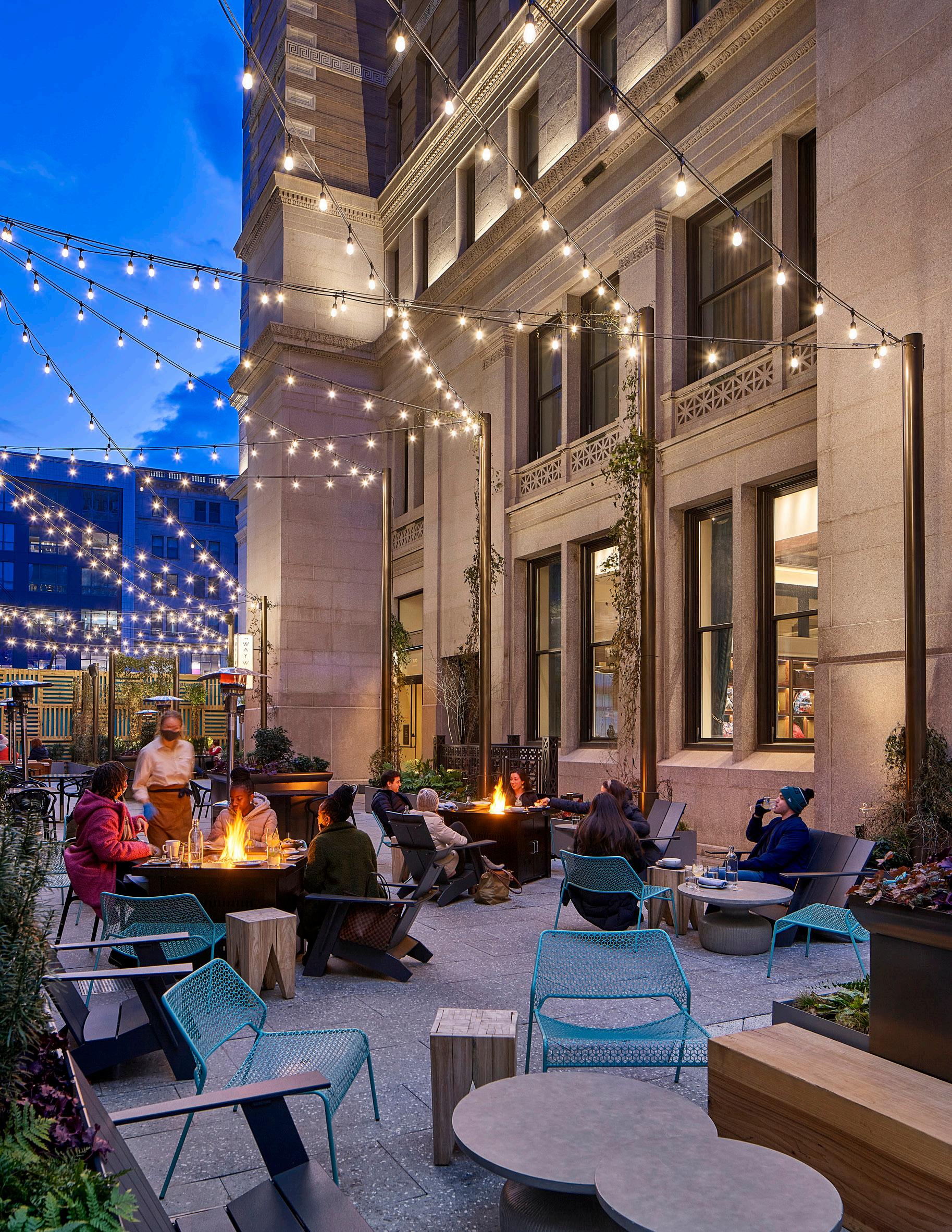




Dear Reader,
Our Human by Design promise means that sustainability is embedded in everything we do. Our staff’s diverse talents and perspectives drive our creativity, allowing us to design beautiful, socially responsible, resource-efficient environments in balance with the world we inhabit. We learn from each other, our work, and the clients and communities we serve.
Our annual State of Sustainability report highlights our commitment to continuous improvement. We are proud to be an operationally carbon-neutral company, offsetting our Scope 1 and 2 emissions through strategic carbon credits and prioritizing methods to directly reduce our carbon footprint. We recently submitted comprehensive data from Perkins Eastman’s US studios for Just label certification, which, in addition to the Just label our Perkins Eastman DC studio received last year, will significantly aid our ability to benchmark our progress in diversity, equity, and inclusion.
In 2023, we increased projects targeting net zero energy and other certifications, deepening our understanding of holistic wellness for people and the planet. Earlier this year, we published Addressing a Multi-Billion Dollar Challenge, which showcases how high-quality school environments enhance educational outcomes, well-being, and community strength. The report, funded by the American Institute of Architects College of Fellows (Latrobe Prize) and J+J Flooring, demonstrates our commitment to research that advances our efforts to elevate the quality of everyday life through the built environment.
Climate change is the greatest challenge of our time. As architects, designers, planners, and representatives of a global firm, we are uniquely positioned to mitigate environmental stresses. We have an obligation to collaborate with clients and professional colleagues to address climate change head-on. Together, we can create a better future.

Shawn
Basler
Co-CEO

Nick
Leahy
Co-CEO

Andrew Adelhardt III
Co-CEO
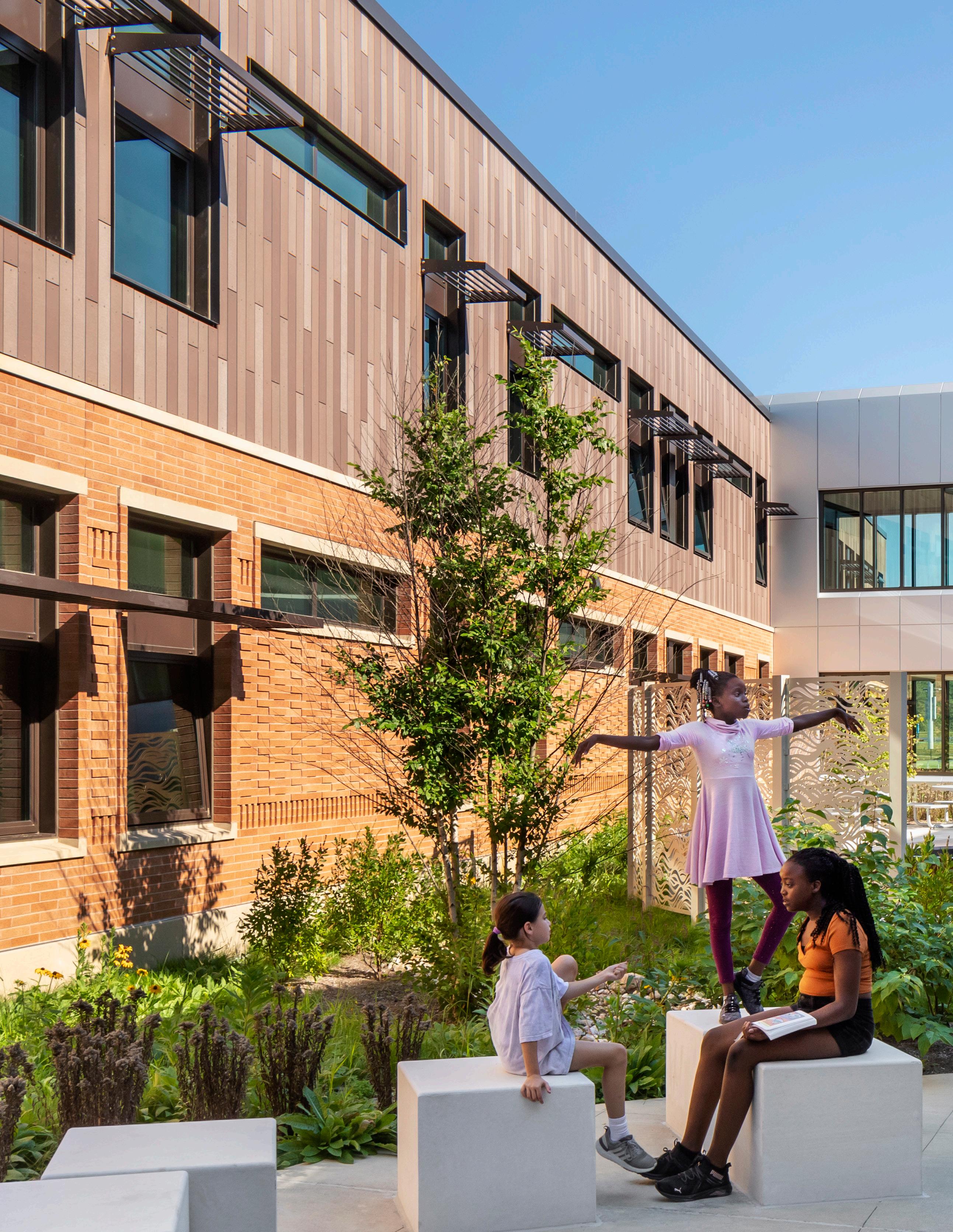

PG. 56 Case Study: Mindful Materials Libraries
PG. 58 10 — Holistic Wellness
PG. 60 Case Study: Mastering Wellness
PG. 62 Case Study: Supporting Wellness through Indoor Environmental Quality
PG. 64 11 — Research
PG. 66 Case Study: Addressing a Multi-Billion Dollar Challenge
PG. 68 12 — Resiliency
PG. 70 Case Study: Resiliency at the Ready
The global sustainability landscape continues to undergo profound changes—marked by pivotal reports, agreements, and regulatory updates. These developments showcase a collective stride toward a greener future, and they emphasize the daunting challenges and promising opportunities within the realm of sustainability.
IPCC’s Stark Reminder: In March 2023, the Intergovernmental Panel on Climate Change (IPCC) “AR6 Synthesis Report”1 issued a dire warning: without drastic measures to reduce fossil fuel consumption, current and planned fossil fuel infrastructure will exceed the carbon budget necessary to limit global warming (keeping global temperature rise at or below 1.5°C). This looming crisis underscores the critical need for global action toward achieving net-zero CO2 emissions.
COP28’s Historic Call to Action: In alignment with the IPCC’s warning, nearly 200 nations made a groundbreaking pledge at the United Nations Framework Convention on Climate Change (UNFCCC) Conference of the Parties to the Convention 28 (COP28) in November 2023 to start “transitioning away from fossil fuels.”2 Despite facing challenges around the depth of commitments and financial support for developing countries, the specific recognition of the role fossil fuels play in the clean-energy transition is a testament to the global commitment toward net-zero greenhouse gas (GHG) pollution by 2050.
Advancing Sustainable Building Standards with LEED v5: Introduced at the 2023 Greenbuild International Conference and Expo, LEED v53 marks a significant evolution in green building certification by expanding LEED to address carbon, health, resilience, and equity in a more comprehensive manner.
CALGreen’s Embodied Carbon Reduction: The 2023 updates to the California Green Building Standards Code4 known as CALGreen, include statewide mandatory measures for embodied carbon reduction. Effective July 2024, the code changes serve as a starting point to minimize the carbon footprint of both new construction and renovation projects, showcasing California’s leadership in sustainable building practices.
Evolving SEC Regulations: The United States Securities and Exchange Commission’s 2023 regulations 5 have expanded the scope of mandatory climate-related disclosures for publicly traded companies. These regulations mark a significant step toward aligning financial stability with environmental stewardship, signaling a shift in policies and business practices.
As we navigate the evolving sustainability landscape, the developments noted here underscore global momentum to increase reporting transparency and establish actionable climate goals. The journey toward a resilient and decarbonized society is a marathon, not a sprint, and the milestones achieved in 2023 are crucial steps forward in this global endeavor.
*Sources:
1. Intergovernmental Panel on Climate Change. (2023). “AR6 Synthesis Report.” Retrieved from IPCC
2. UN Climate Change News. (2023, December 13).
“COP28 Agreement Signals ‘Beginning of the End’ of the Fossil Fuel Era.” Retrieved from UNFCCC
3. USGBC. (2023). “LEED v5.” Retrieved from USGBC
4. AIA California. (2023). “CALGreen Checklists.” Retrieved from AIA California
5. United States Securities and Exchange Commission. (2023). “SEC Adopts Rules to Enhance and Standardize Climate-Related Disclosures for Investors.” Retrieved from SEC

In this executive summary, we report on the status of our firm’s Sustainability Resolution, addressing our commitments and goals in critical areas.
We strive to be a carbonneutral firm—in both our operations and in our work with clients.
• 48.9% predicted EUI reduction from Commercial Buildings Energy Consumption Survey (CBECS) baseline
• 49.7% of projects with energy models
• Offsetting Scope 1 and 2 carbon emissions from our operations
• Participating in CDP’s operational carbon emissions disclosure forum
• Tracking strategies for embodied carbon reduction across portfolio
• Aligning our strategies with the Science-Based Targets initiative (SBTi) for effective carbon reduction efforts
• Developing carbon scorecards for office-level accountability
• Working with our consultants to target Scope 3 emissions improvements
We strive to correct the inequities in our practice, our projects, and our communities, and to celebrate diversity and culture.
• Operating a robust mentorship program
• Expanding Employee Resource Groups (ERGs)
• Engaging in the equity-building program “Pathways to Equity”
• Obtaining Just label for Perkins Eastman’s US offices
• Continuing investment in the mentorship program
• Renewing Perkins Eastman DC Just label
• Pursuing Employee Resource Group Playbook to support ERGs
• Adjusting policies in line with “Pathways to Equity” program
We strive for the materials we use to have a net-positive benefit on human health, climate health, ecosystem health, social health, and equity, and to contribute to a circular economy.
• Engaging in the AIA Materials Pledge
• Advocating for industry leadership
• Updating material library policies and criteria
• Highlighting material selection in the firm’s Materials Action Plan
• Refining project specifications standards to improve transparency and performance
• Establishing benchmarking and performance targets
We strive to be curious — to use applied research to enhance and advance our work.
We strive to approach wellness holistically—in terms of people and the planet, and at all scales of our work.
• Utilizing internal research teams to measure design impact
• Collaborating externally to broaden research scope
• Publishing the Latrobe Prize research grant study Addressing a Multi-Billion Dollar Challenge
• Expanding building life-cycle assessments
• Committing to ongoing questioning of findings within the industry
We strive to lead with passive design strategies, as this approach provides the key to reducing future climate emissions and improving livability and resiliency.
• Integrating a research-driven approach to address wellness holistically
• Incorporating wellness goals into project kickoff discussions
• Implementing design strategies with a focus on people and planetary wellness
• Continuing to refine our approach through case studies and internal databases
• Layering in a broader definition of resilience and sustainability into Planning + Urban Design and Large Scale Mixed-Use practices
• Developing Metrics of Success for project guidelines and evaluation
• Expanding application of resilience principles and Metrics of Success across all practice areas


Our culture is embodied in our Human by Design ethos.
We believe design should have a positive impact on people’s lives and the environment. To work toward a better future, we leverage our global resources to deliver design solutions with care and craft.
Sustainability—social, economic, and environmental—is the cornerstone of our work. When we first started building a sustainability initiative more than 20 years ago, we knew it would be both a technical and cultural challenge. The initiative
has focused on aiding and growing our design culture. We have developed a robust network of motivated and talented people by providing exceptional resources, compelling educational opportunities, and technical expertise. Today, sustainability is infused into our culture.
Culture attracts world-class talent; it influences alignment, focus, and performance. Our culture continues to evolve, with Human by Design at its core. This report starts with a review of our culture, our progress, and our goals.

Sustainability is a collective endeavor that defines our work. Our Sustainability Network supports our Human by Design ethos. It includes our Sustainability Leads, Green Coordinator Network, Regional Sustainability Specialists, Firmwide Sustainability Team, and Leadership Advisory Committee. More than a structure, our network is a vital community of dedicated professionals who bring their expertise, creativity, and passion for sustainability.
1. Sustainability Leads
2. Green Coordinator Network
3. Regional Sustainability Specialists
4. Firmwide Sustainability Team
5. Leadership Advisory Committee
1
2 3
4
5
The Firmwide Sustainability Team oversees initiatives across all Perkins Eastman studios. This team works to develop policies and effective sustainability strategies and coordinates the firm’s global strategy to improve the performance of all projects. The firmwide team also collaborates with project teams to provide sustainability recommendations and support projects pursuing high sustainability targets.

Leader of Corporate Sustainability
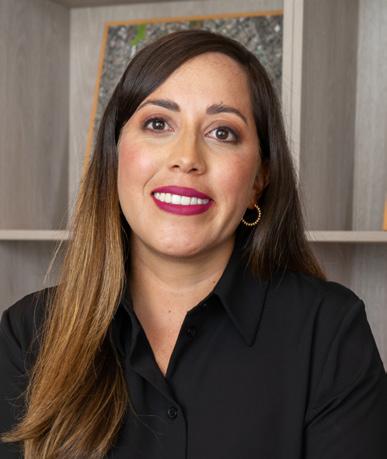

DIRKS Senior Sustainability Specialist
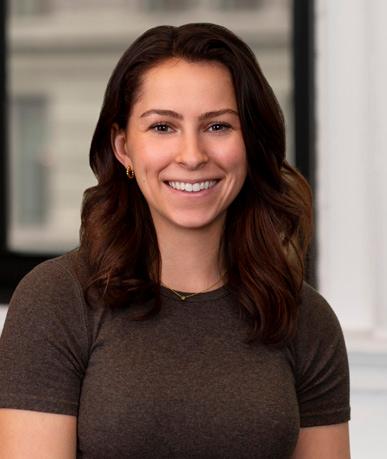
Corporate Sustainability


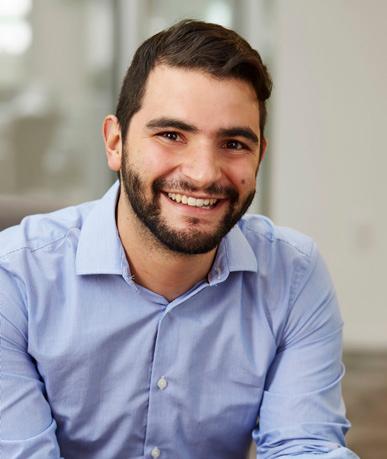
Performance Analytics, and Tools
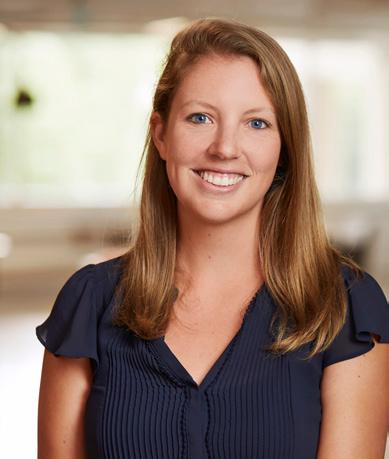
The Advisory Committee is composed of Perkins Eastman leaders from throughout the firm who provide input and guidance on the direction of sustainability initiatives.

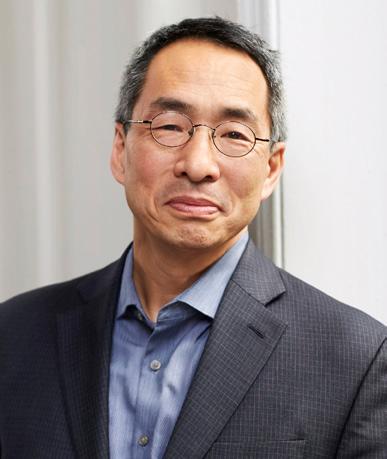



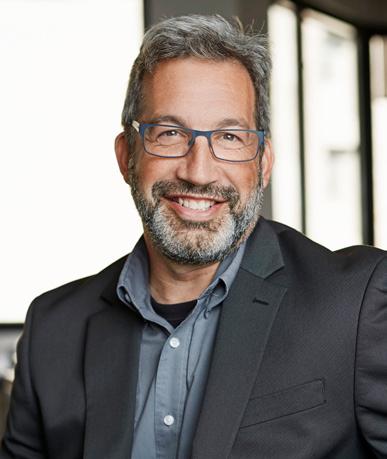
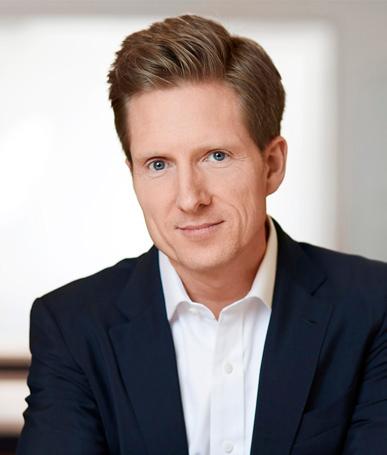












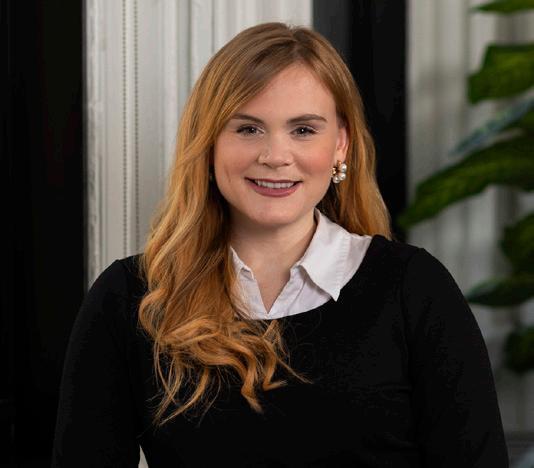
In addition to the Firmwide Sustainability Team, Green Coordinators embedded within our 23 studios are heavily involved in achieving our goal to become a leading voice in the profession’s sustainability efforts.

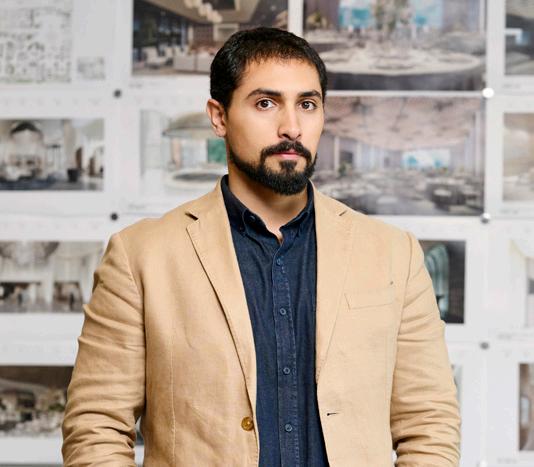
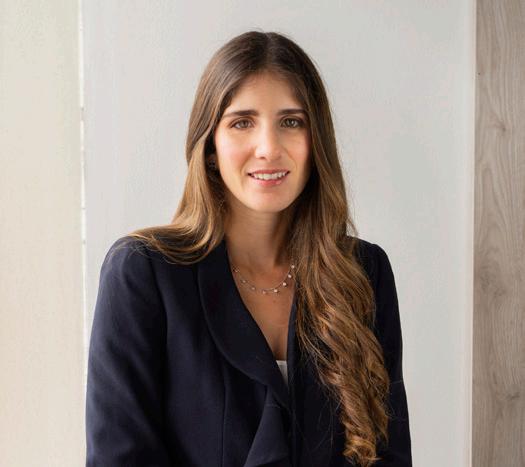






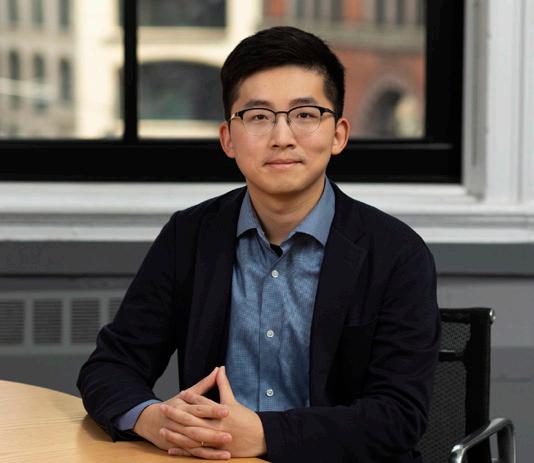

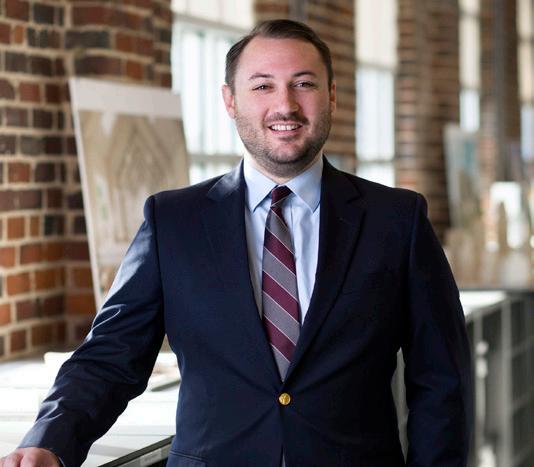
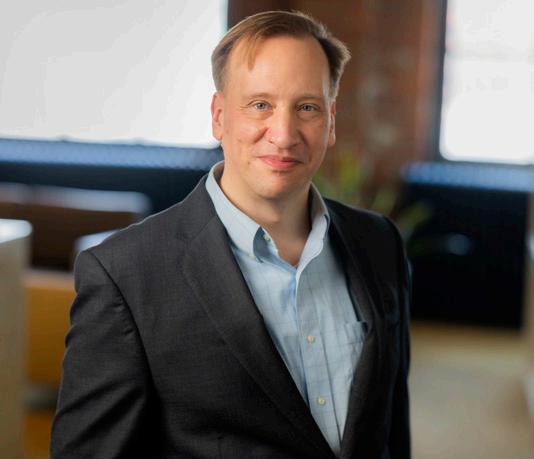


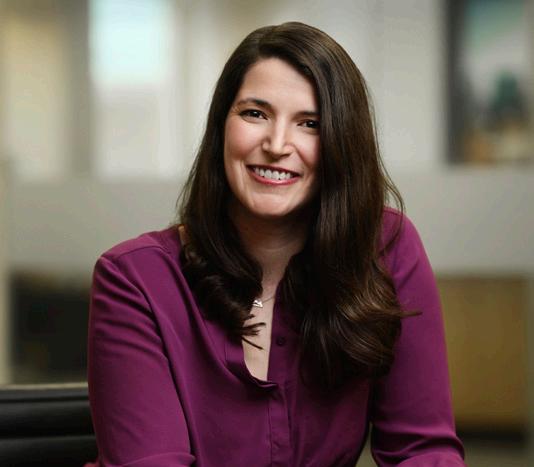

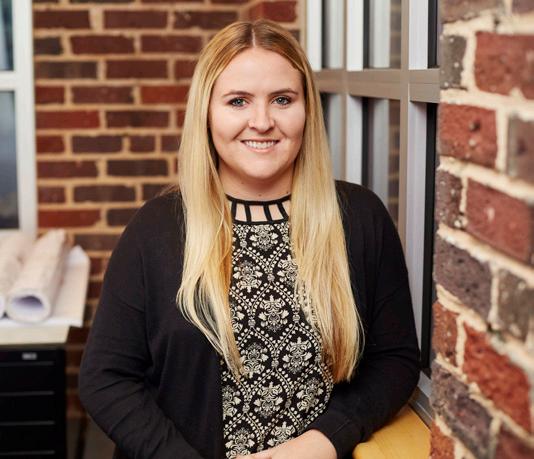


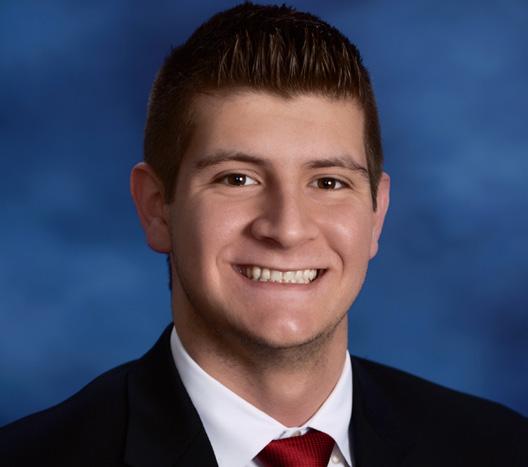



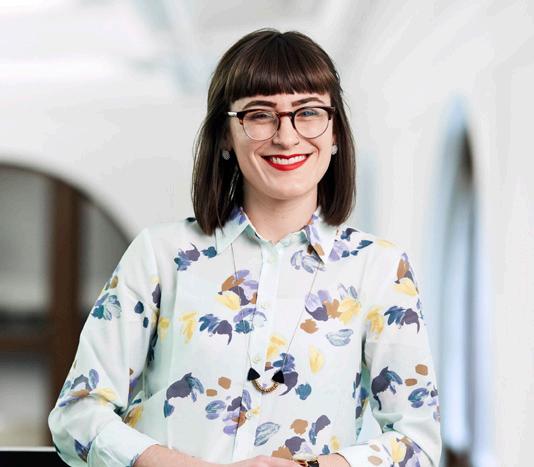



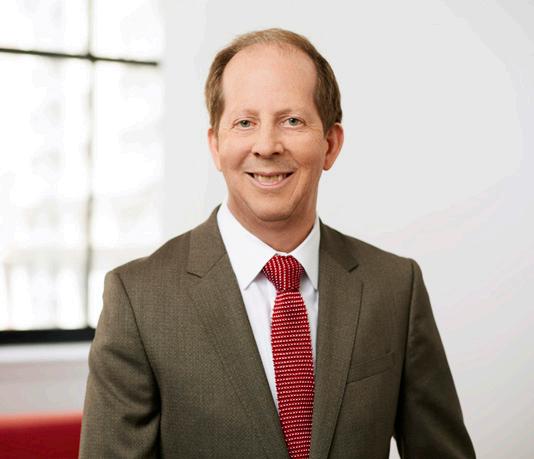
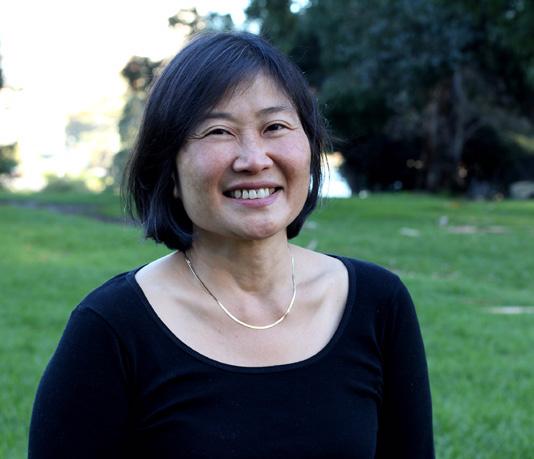
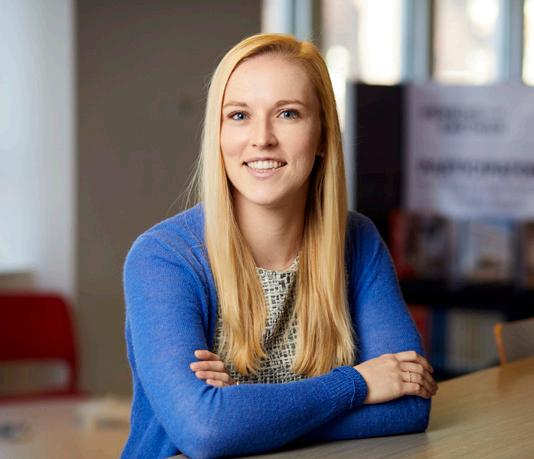
Our Sustainability Network supports eight working subcommittees, each of which plays a crucial role in weaving holistic sustainability into the fabric of our firm and the communities we serve.
Our Communications Subcommittee is dedicated to enhancing our internal and external sustainability narratives. Through the creation of strategic marketing materials, social media campaigns, and website enhancements, we’re fostering a deeper understanding and engagement with our clients and the broader community.
The Corporate Sustainability Subcommittee leads by example, demonstrating how sustainable operations are seamlessly integrated into our corporate culture. Through the development of our forthcoming Sustainable Operations Manual and initiatives like the Office Scorecards and Carbon Offsetting program, we are making tangible strides in our commitment to sustainability in every aspect of our operations.
The Data Analytics and Tools Subcommittee is focused on enhancing our performance analysis software to better support our design process. Currently, we are concentrating on the establishment of a Sustainability Tools Database that will empower our designers with the knowledge and resources they need to integrate sustainability into their design processes.
For 2024, our Energy/Carbon Subcommittee is working to deepen our knowledge and implementation of energy-efficient and carbon-reducing practices. We aim to significantly lower our projects’ carbon footprints by developing an Embodied Carbon Reduction Plan, rolling out Passive House resources, and hosting an annual, internal design competition centered on decarbonization. Through rigorous analysis of our AIA 2030 Commitment data, along with the development of high- and low-performance case studies, we’re tracking progress.
This year, our Knowledge Management Subcommittee has taken strides to enhance firmwide access to sustainable design methods and best practices. With the rollout of quarterly education modules paired with roundtable discussions, we’re cultivating an intentional learning environment that spans the breadth of sustainability in architecture.
Our focus on material health emphasizes the importance of selecting products that support the well-being of humans and the environment. For 2024, we are developing benchmarks and tracking progress in alignment with the American Institute of Architects Architecture and Design (AIA A&D) Materials Pledge. We are supporting this effort through a multifaceted approach comprising educational resources, materials library improvements, specification overhauls, and strategic partnerships.
New in 2024, the Pitch Perfect Subcommittee is helping to equip our teams with lessons learned throughout the firm. Compiling these lessons helps to inform common discussion points and questions, crucial to strengthening our advocacy for sustainable design in every client interaction and external partnership.
The Practice Area Metrics Subcommittee is committed to elevating the performance bar across all practice areas by standardizing metrics that assess the social, economic, and environmental impact of our work. Through data collection and analysis, we’re identifying key success metrics and generating case studies that both inform high-performance design decisions through the entirety of the project timeline and capture our sustainability impact more comprehensively.
Perkins Eastman’s dedication to sustainability education reflects our commitment to empowering employees with the tools and knowledge to champion sustainable practices.
Our Sustainability Network focuses on creating and sharing educational materials that respond to our employees’ needs and the realities of sustainable design. From workshops to training videos, we’ve tailored our resources to be practical, informative, and directly applicable to our work. This past year we hosted 16 in-house educational sessions with topics such as “Holistic Wellness in the Built Environment” and “Building Electrification.”
Sustainability Leads—design team members working to integrate sustainability into our process—are critical to our Sustainability Network. To support these staff members, we’ve developed a Sustainability Lead cohort program in which participants, nominated by their studio leadership, engage in a series of workshops covering a broad spectrum of sustainability topics. This approach empowers our sustainability leads with essential knowledge. This past year, 40 individuals participated in our cohort program, each featuring 12 sessions covering sustainability topics including “Passive Design Strategies” and “How to Talk to Clients.”
Sharing our lessons learned and research findings with the broader industry is one of our priorities. Over the course of the last year, we presented at nine conferences, including our largest participation to date at the Greenbuild International Conference, where we showcased some of our exciting sustainability stories to date: the District Wharf, John Lewis Elementary School, and Benjamin Banneker Academic High School. This exchange of knowledge is vital, enabling us to stay informed of the latest ideas being pursued by our peers and to serve as an influential voice in the evolving landscape of sustainable design.
As we move forward, we remain focused on fostering a culture of sustainability rooted in knowledge, collaboration, and action. For 2024, we are encouraging a culture of continuous learning with the launch of a new year-round learning series that will be offered firmwide to all staff members.
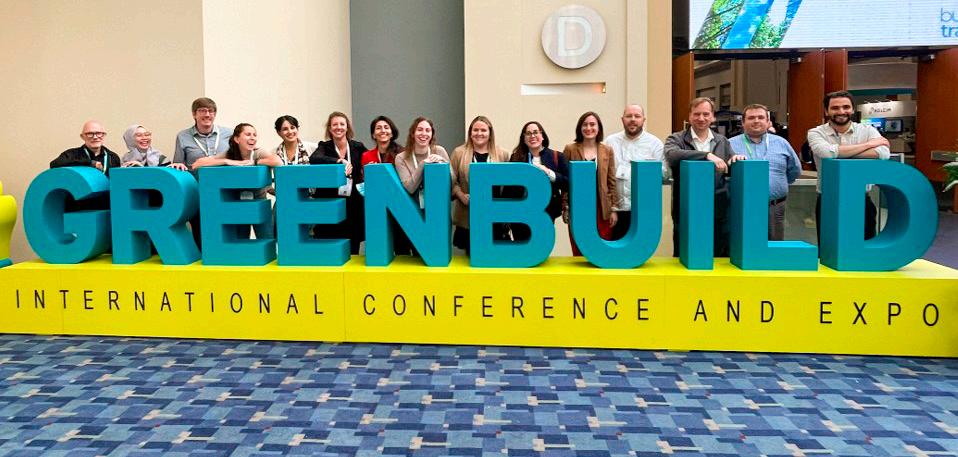
FIRMWIDE SUSTAINABILITY TEAM AND GREEN COORDINATORS AT THE 2023 GREENBUILD INTERNATIONAL CONFERENCE

THE FIRM LED A TOUR OF THE DISTRICT WHARF IN WASHINGTON, DC, FOR 2023 GREENBUILD


PERKINS EASTMAN HOSTED THE SUSTAINABLE DESIGN LEADERS’ SHOW & TELL AT 2023 GREENBUILD IN OUR WASHINGTON, DC, STUDIO
At Perkins Eastman, the celebration of sustainability is woven into the fabric of our culture.
Our studios contribute to our firmwide sustainability goals and champion our values in their local communities. This year, we continue to celebrate the hard work and dedication of our staff for their commitment to sustainable practices and processes.
Our annual Earth Week celebration brings together all studios for a week of activities including trivia contests and neighborhood cleanup efforts. They remind us of the positive impact we can make in our communities and allow us to take tangible steps in the right direction.
Through our participation in the Big Green Commute (BGC), an initiative founded by ZGF Architects in Washington, DC, we challenge our staff to rethink their commuting habits. We have adapted this model to create a firmwide competition. Last May, our Vancouver studio led the way with an average of 8.91 points (10 points represents the cleanest commute possible) followed closely by one of our New York City studios with an average of 8.54 points. This friendly competition both highlights alternative commuting methods and underscores our efforts to reduce our carbon footprint.
A highlight of the year is the continuation of our annual firmwide accreditation competition, which encourages our staff to gain LEED, WELL, or similar sustainability-related accreditations. Our goal is to have 50% of Perkins Eastman employees hold a sustainability accreditation. Why? We are working to embed sustainability in our design thinking, and sustainability accreditations is a great way to get those wheels turning. We award trophies to the studios with the highest percentage of accredited staff and highest rate of increase, and we hold an annual raffle for newly accredited staff. Our accreditation competition sparks enthusiasm and drives our professional growth.
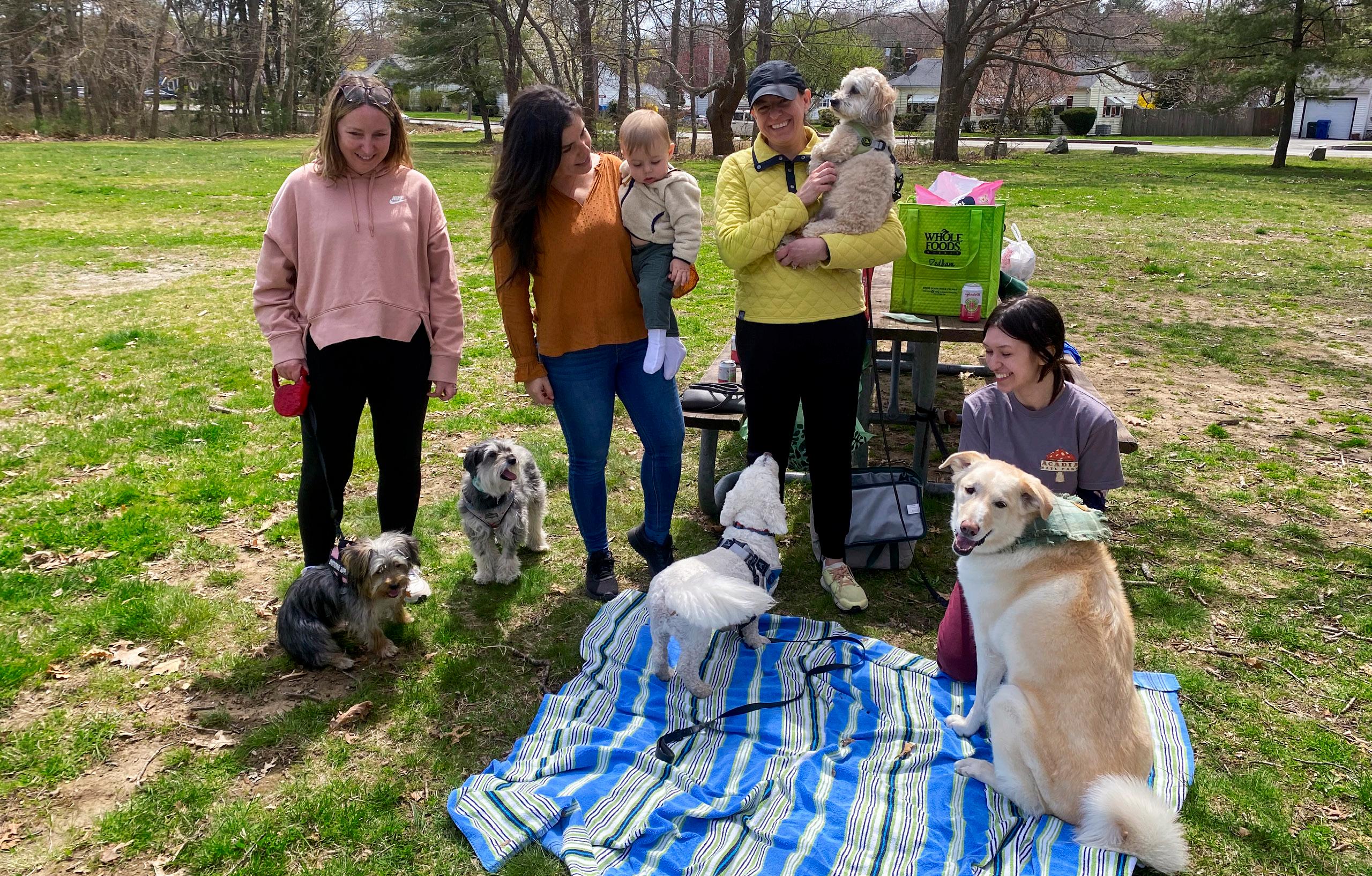
BOSTON STUDIO HELD THEIR EARTH DAY PICNIC FOLLOWING COMMUNITY CLEANUP VOLUNTEER ACTIVITIES AT HOUGHTON’S POND IN MILTON, MA.


Our work is fueled by a multitude of voices and perspectives. The planet has limited resources, but we have unlimited potential to preserve those resources as long as we welcome and cultivate diverse talents. Diversity, equity, and inclusion (DE&I) are integral to the sustainability of the environment.
Last year, our State of Sustainability report highlighted our firmwide DE&I mission, vision, commitments, and goals for the first time. This year we are highlighting our progress related to transparency, mentorship, inclusion, and equity.
Our approach to DE&I is characterized by continuous evolution rather than definitive endpoints. Our commitment to transparency, measurement, and accountability enables us to recognize areas for improvement and celebrate our progress. To help us with this commitment, we chose to pursue the International Living Future Institute’s (ILFI) Just label, which serves as a transparency tool for organizations—akin to a nutrition label for social justice and equity. In 2022, we received a Just label for our Perkins Eastman DC studio, which inspired our pursuit of the label for Perkins Eastman Architects.
This year, after extensive data collection and policy adaptation, we’ve submitted the required data to ILFI. We expect to receive the Just label for Perkins Eastman’s US studios within the year. The value of the Just label lies in its capacity to foster open dialogue that drives strategic and meaningful change. The label will give us a benchmark against which to measure our progress toward our diversity, equity, and inclusion goals.
Perkins Eastman has one of the most robust mentorship programs in the industry, a commitment to supporting our staff’s professional development and growth. Everyone who requests a mentor is paired with one, and pairings are encouraged across studios, practice areas, and disciplines. The program is governed by a series of tracks that help guide the pairings and their activities. Recent tracks include: Work/Life Balance, Exploring Career Journeys, Networking, and Technical Skills. A DE&I track encourages pairings that involve a focus on valuing diversity, building equity, and incorporating inclusion in our practice and projects. When requested, pairings of intentional commonalities are made to create safe spaces for shared experiences. For instance, a junior female designer may wish to be paired with a senior female designer to learn how to develop her voice and navigate a historically male-dominated industry.
Our mentorship pairings often happen organically when someone is seeking to learn a particular skill or competency. An ideal mentor may come from a different generation, gender, race, ethnicity, and/or from a different religion or cultural background.
To support pairings across layers of demographic difference, the mentorship program provides materials to help guide conversations, lay the groundwork for understanding, and encourage bonding around commonalities while celebrating differences.
By providing professional support to those who may not have received it in the past, intentional mentorship builds equity. As our staff continues to become more diverse, we will continue to invest in this program to guide our employees through their career journeys.



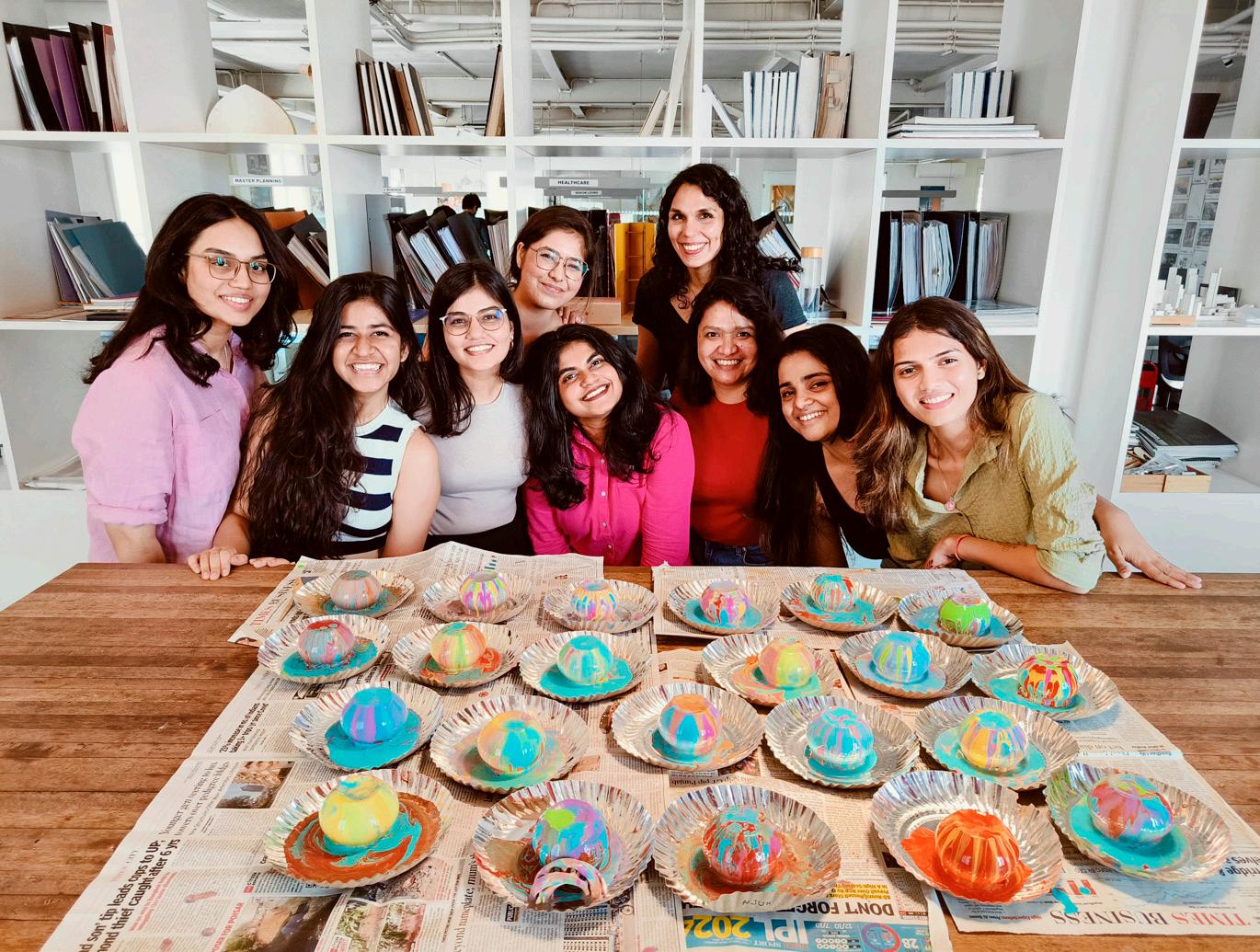
Celebrating the diverse cultural heritages and backgrounds of our staff members is of great importance to our Human by Design ethos, as well as a wonderful way for us to get to know one another. Our Employee Resource Groups (ERGs) have helped to build relationships across studios and educate our people on the diversity of our staff. These groups have grown organically, from studio-level small gatherings into robust enterprise-wide organizations and include PE Women Lead, PE Asia, the Minority Leadership Network, PE PRIDE, and the Latinx Leadership Network. Each ERG has its own manifestation at the studio and regional level based on the interests and culture of each office.
Due to these variations, our employees look for support and guidance to lead and continuously evolve these ERGs at each level of the firm. This year, we addressed this by publishing our ERG Playbook, a guide to advise studios on how to lead ERGs locally and to provide information, resources, and materials for planning and execution of events, gatherings, conversations, and partnerships.
In addition to supporting the constituency group of each ERG, the ERG Playbook holistically enhances our Human by Design culture. It provides resources and direction for allies who wish to be empathetic and involved but may not know how to engage.
Perkins Eastman engaged Open Architecture Collaborative (OAC), a nonprofit educational organization based in San Francisco, to facilitate its equity-building series, “Pathways to Equity.” The program entails a series of six, two-hour sessions in which participants confront the inequities inherent in the practice of architecture, learn techniques for increasing equity within our firm, and develop empathic leadership skills that go far beyond the traditional focus of leadership trainings. Perkins Eastman signed on for three
annual cohorts of 20 people each, reflecting our strong commitment to build equity and implement change within Perkins Eastman.
The first cohort completed the program in spring 2023 and was comprised of junior- and mid-level staff who were already leading studio-based DE&I efforts. This group provided valuable feedback about the program and recommended changes to our practices and policies. Their summary document is a sturdy platform upon which the second cohort could build and expand.
The second cohort intentionally consisted of firm leadership—people who could further assess the status of our firm’s journey toward a more equitable work environment. The members of this cohort completed their sessions in April 2024 and have established an implementation task force that will continue to carry the work forward. We intend to implement policy and practical changes in 2024 with others to follow soon after. Some of these areas of focus are detailed in the goals chart.
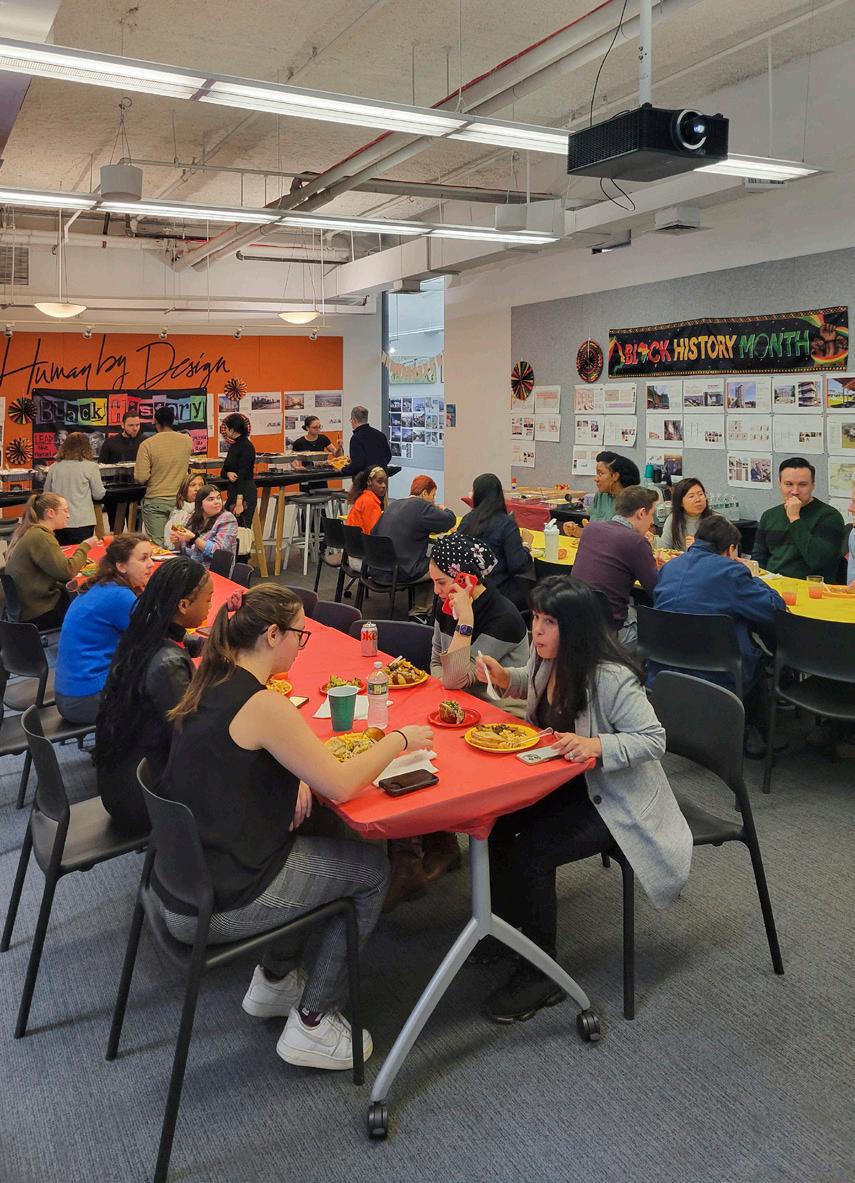






While our operations represent a small portion of our total carbon footprint in comparison to the carbon impact of our design work, they are a critical component in supporting a culture of sustainability in our firm. We continue to work toward reducing our environmental impact in all our operations.
In 2023, Perkins Eastman achieved operational carbon neutrality. This milestone was reached via two critical efforts. By expanding upon the groundwork laid in previous years, the first effort involved the further development of GHG accounting process. This effort is supported through our ongoing partnership with Verdis Group for the third-party verification of our GHG inventory across the US Environmental Protection Agency’s Scopes 1, 2, and 3, which are defined in detail on the following pages.
The second effort was achieved by offsetting our Scope 1 and 2 emissions through the strategic acquisition of carbon credits. In collaboration with Cloverly, a consultancy with a curated global carbon market platform, we undertook a thorough evaluation of available carbon markets to ensure that our investments align with our mission.
In a significant step toward increased transparency, we also disclosed our verified data in the 2023 cycle to CDP, a nonprofit global system that measures environmental impacts, and, moving forward, intend to continue with annual disclosure.
Recognizing that transparency and carbon offsets are just the first steps towards our broader goals, we are simultaneously prioritizing methods to directly reduce our carbon footprint. With initiatives such as green commuting competitions, waste audits, and improving office supply purchases, we are constantly working to reduce our operational carbon emissions.

Fostering a culture of accountability and collaboration at an office level is necessary to reduce our environmental impact as a corporation. To address our operational carbon footprint, we are developing materials to help illuminate our emissions data by office location. Our “Carbon Scorecards” will enable offices to engage more specifically with their contribution to firm emissions. We also plan to leverage this information to initiate a carbon accountability process within each office, so we can tie our sustainable operations manual to annual action items designed to reduce our carbon footprint.
Like most corporations of our size, our carbon footprint is complex. For example, we have limited influence over the base building systems of the office spaces we lease, and, therefore, over the GHG emissions associated with heating or cooling our workplaces. However, we can ensure that recycling and composting are available in our offices, and we can encourage staff to opt for lower carbon office commutes such as public transit, biking, and walking. By providing the data, and then identifying opportunities to reduce our emissions, we foster a sustainable culture of accountability.
While we have addressed our Scope 1 and 2 emissions through carbon offsets for now, the substantial footprint of our Scope 3 emissions, related to our broader business operations, remains a pressing challenge. We are starting to explore the professional services portion of our Scope 3 emissions, which are associated with our consultants.
At more than 9,000 metric tons of CO2e, they represent 71% of our total emissions and 79% of our Scope 3 emissions. In an effort to spark industry conversation regarding the emissions impact from professional services, we contacted the top 25 consultants (predominantly mechanical, electrical, MEP, and structural engineering firms) that represent the largest percentage of our professional services. Our goal was to understand their carbon reporting and offsetting processes and further inform our numbers. While none of them are offsetting yet, many of our consultants have begun to annually report on their carbon emissions. We will continue to advocate for them to share this information and encourage the consultants we work with to join us on a path toward carbon neutrality.
Though professional services represent the largest percentage of our Scope 3 emissions, we are continuing to target all sources of emissions, especially those strongly connected to our firmwide culture. For example, employee commuting represents 4% of our carbon emissions, but we organize an annual commuting competition (as mentioned in the “Our Culture“ section), because commuting is an area in which we can impact change. When comparing our competition habits to our business-as-usual commuting practices, we found that if greener commuting habits were adopted across our entire firm, we would save approximately 290 metric tons of CO 2 e, an amount equivalent to the carbon capture of 14,500 mature trees!
The US Environmental Protection Agency (EPA) has categorized GHG Emissions into three scopes.
Direct emissions that occur from sources that are controlled or owned by an organization.
Supply chain emissions that occur in the value chain of the reporting company.
Indirect emissions associated with the purchase of electricity, steam, heat, or cooling that are a result of the organization’s purchased energy use.
For more information on our third-party verified greenhouse gas emissions, please see this report from our verifier, Verdis Group.
As part of our commitment to carbon neutrality and in line with our ethos of Human by Design, we have curated a diversified portfolio of carbon offsets for 2023. Cloverly, a trusted carbon market platform, has helped us select high-quality carbon credits from a diverse range of projects. Each project has been thoroughly vetted to ensure its integrity and impact, providing us with confidence in the validity of our offsets in a volatile carbon market.
This portfolio not only offsets our Scope 1 and 2 emissions but also resonates with the values and projects of Perkins Eastman. Additionally, these projects align with 15 of the 17 United Nations Sustainable Development Goals (SDGs), reinforcing our dedication to global sustainability.
Our strategy includes a balance of carbon avoidance and removal credits. Carbon avoidance credits, which are more plentiful and cost-effective, prevent the release of
CO 2 emissions. Carbon removal credits, though more expensive and less available, actively reduce atmospheric CO 2 levels. This balanced approach ensures both immediate and long-term impact.
Looking ahead, we will continue to evaluate and refine our carbon offset strategies to align with our sustainability goals. We aim to increase engagement with stakeholders, including clients and local communities, to promote and support these initiatives. Enhancing our transparency and reporting mechanisms will ensure accountability in our carbon offset projects.
By carefully selecting projects that offer both environmental and social benefits, we uphold our commitment to Human by Design, ensuring that our actions today pave the way for a sustainable future.
Our 2023 carbon offset portfolio includes five carefully chosen projects:
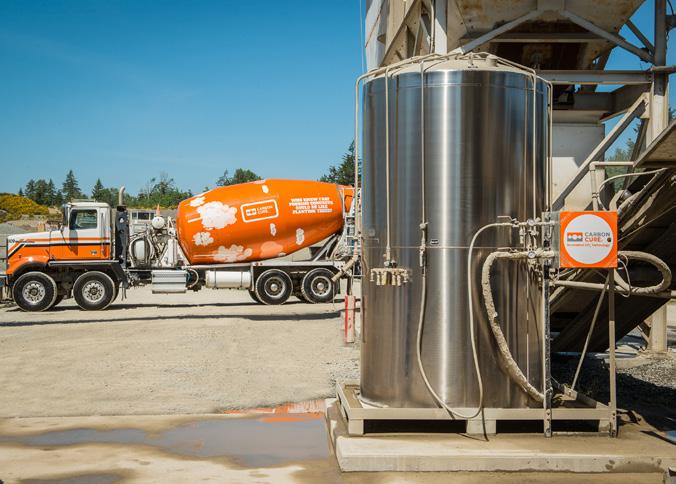
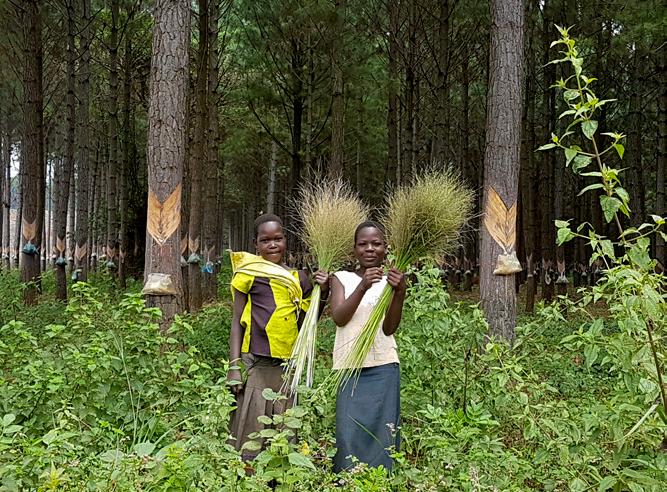


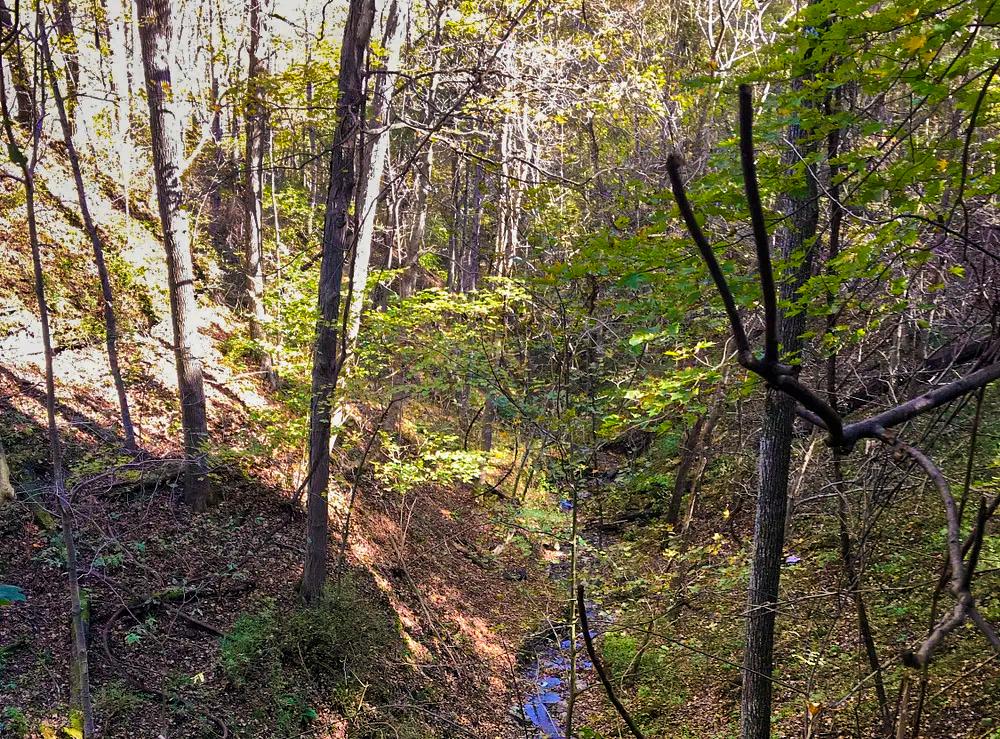
1. CarbonCure in the United States: This project utilizes innovative technology to transform waste CO2 into mineralized CO2, enhancing its physical properties and providing permanent carbon storage within concrete. By reducing the carbon intensity of cement, minimizing cement usage, and lowering energy requirements for concrete production, CarbonCure addresses the significant challenge of decarbonizing the built environment, a critical focus for our industry.
2. Bukaleba Forest Project in Uganda: Building on the work we’ve been doing in Uganda since 2018, this reforestation initiative promotes sustainable forest management, carbon sequestration, and community development. It provides direct and indirect employment to more than 600 people and adheres to the highest corporate, social, and environmental standards.
3. Skylands Region Grocer in the United States: In rural New Jersey, this project implements an advanced refrigeration system in a family-run supermarket, reducing emissions by nearly 99%. The CO 2 system displaces traditional refrigerants, addresses groundwater contamination, and empowers the local store to adopt climate-friendly practices.
4. Indian Carboneers in India: Biochar produces a type of charcoal that boosts soil health, sequesters carbon, and improves crop yield. This biochar project provides high-quality carbon removal and offers significant social co-benefits, including promoting gender equality, good health, and reduced inequalities. It exemplifies our commitment to impactful and socially responsible carbon offsets.
5. Buena Vista Heights Conservation Area in the United States: Located near our Pittsburgh studio, this urban forestry project preserves 124 acres of woodlands, safeguarding wildlife habitats and clean drinking water. Beyond its ecological significance, it provides partnership and volunteer opportunities, with future collaborations already being planned between the project owner and our Pittsburgh studio.
During our 2022 and 2023 firmwide waste audits, most of our studios embraced a temporary waste-management system, replacing individual trash bins with centralized landfill, recycling, and compost bins. At the close of the audit, while most of our studios chose to reinstate individual bins, our New York and Washington, DC, studios permanently adopted the centralized bins approach in 2023, creating an opportunity for a significant cultural transformation across our firm.
We have found that the convenience of individual waste bins causes much of our compostable and recyclable waste to end up in the landfills. Centralized bins dramatically improve our waste disposal practices and make staff more mindful of their own habits. Centralized bins also allow us to significantly reduce the quantity of plastic bags used for waste collection.
In both New York and Washington, DC, studios we have paired these waste management changes with educational sessions on what should be composted, recycled, or sent to landfill. Ultimately, it’s a change-management challenge; altering how we interact with waste and being more intentional are ways to foster a culture of sustainability in our operations.



NEW YORK STUDIO EARTH DAY LUNCH & LEARN COMPOSTING EVENT


The aim is to produce beautiful, resource-efficient design that contributes to people’s quality of life in balance with the world we inhabit. Sustainability is fundamental to that goal.
In 2023, we completed our third Annual Excellence Portfolio (AEP)—an examination and celebration of current work that advances the built environment through the firm’s ethos of Human by Design. The AEP measures our progress as a design firm and honors our staff’s creative energies. It provides opportunities for rigorous design discussions and assessment of our high-performance goals, and it helps us build a project reference library—an archive of ideas accessible firmwide.
With 53 submissions from 23 studios across our firm, the 2023 portfolio reflects our broad and inclusive definition of excellence: work that demonstrates a clear vision, embodies holistic high-performance strategies, synthesizes complexity, and prioritizes stewardship of the environment—each a critical component of our ethos.
In 2023, we increased the number of projects targeting higher levels of performance, more deeply integrating sustainability into their design process, and reaching loftier goals.
Nine projects across four continents achieved a major certification milestone, including a senior living community in China and our own studio in Ecuador—and we have more than a hundred projects registered and on a path toward certification (LEED, WELL, Passive House, and Envision, among others). We saw an explosion in projects targeting Net Zero Energy in 2023, with 17 new projects working toward that goal, mostly within the education sector. In addition, we have two new projects targeting Passive House, one new project targeting WELL, and one new project targeting LEED Platinum.
Although sustainability is broader than third-party market standards, these certifications are useful guideposts to measure our progress.


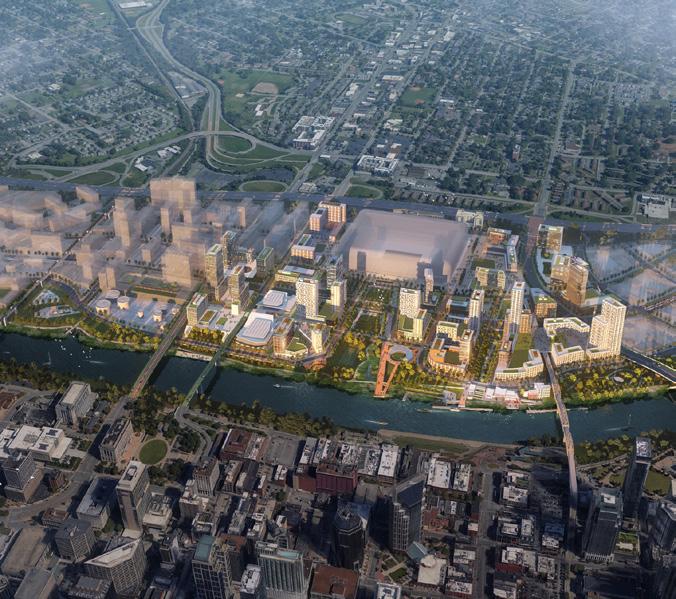


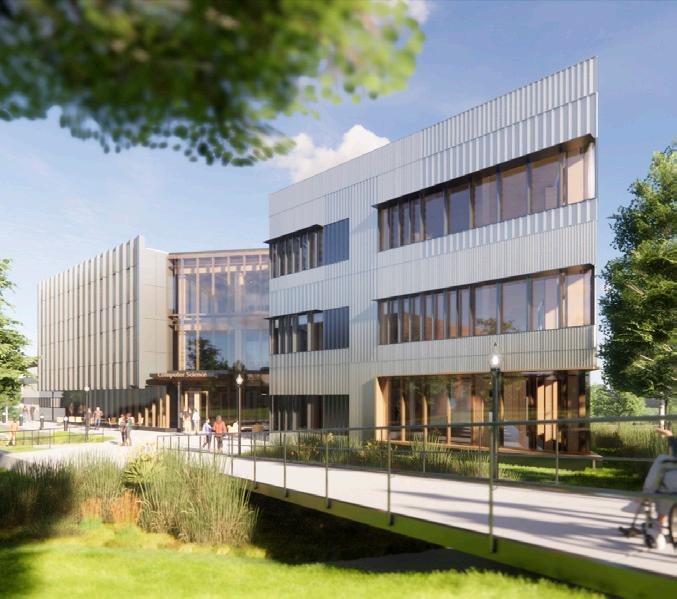



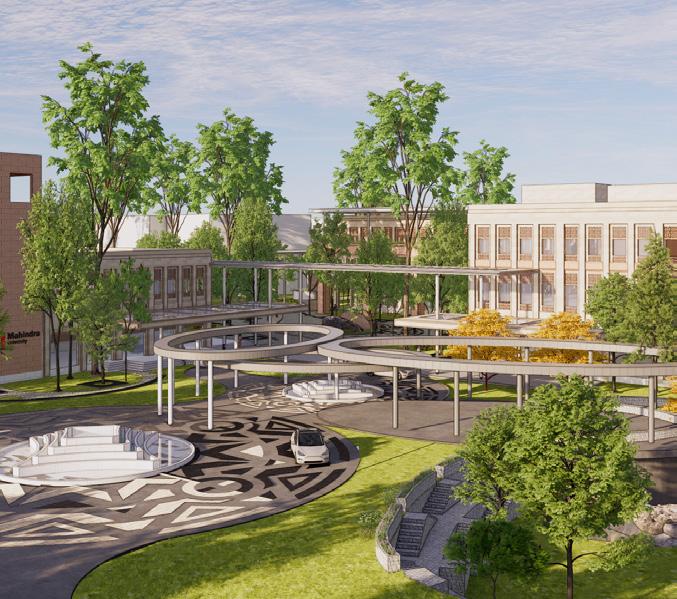
Perkins Eastman has a total of





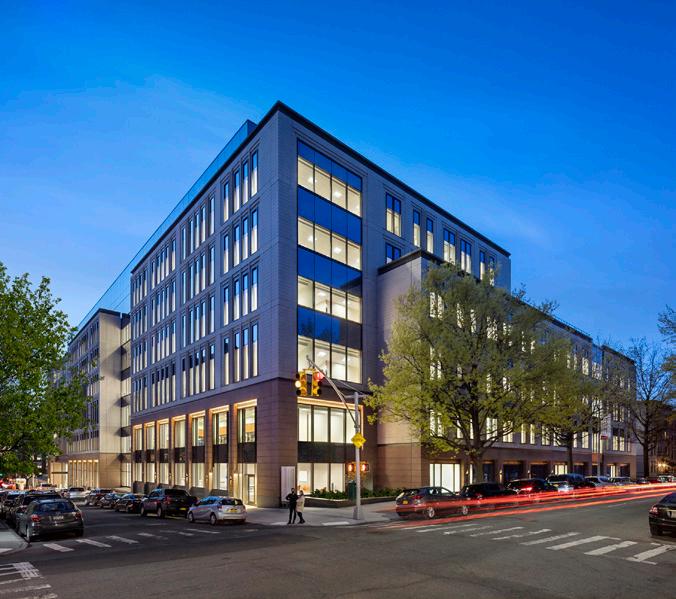



WORLD BANK UGANDA, PRELIMINARY EDGE

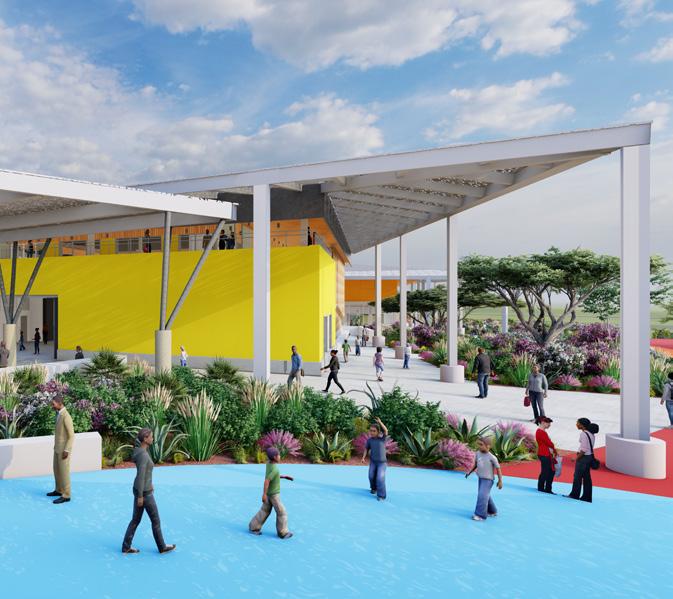

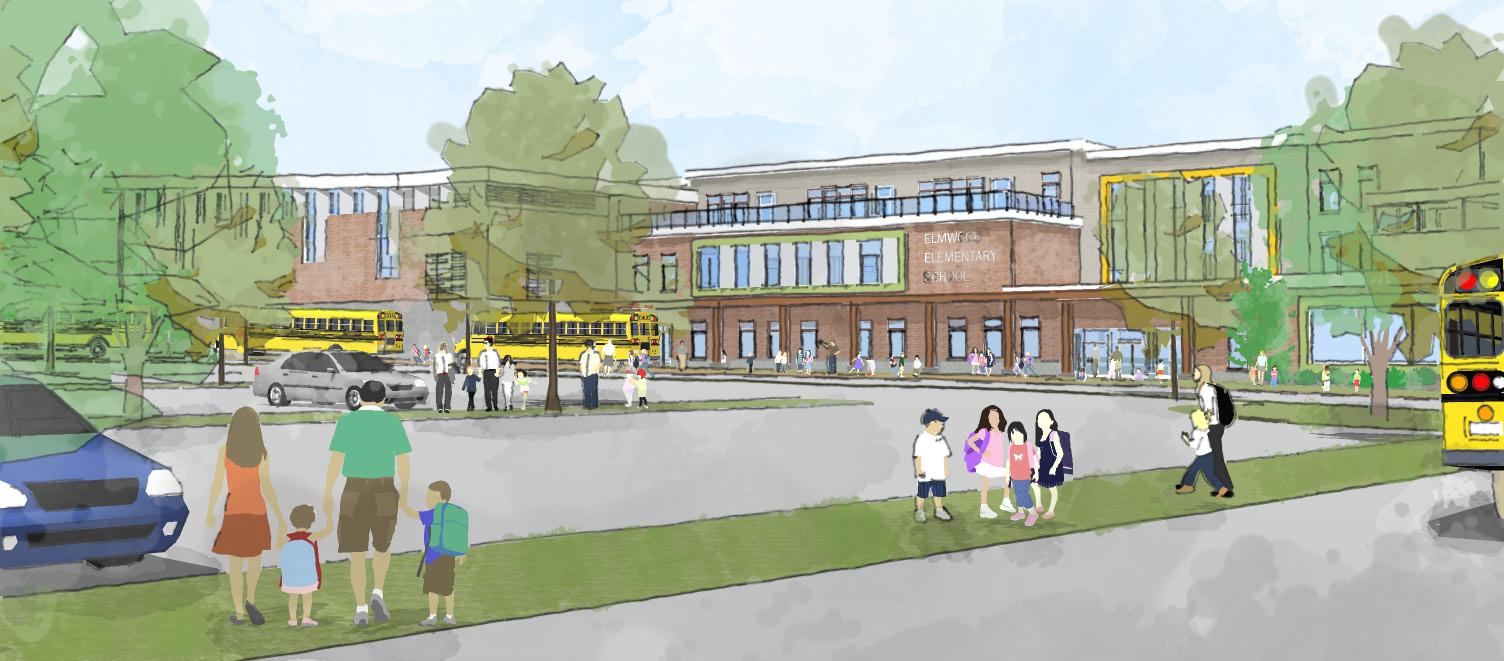



Perkins Eastman has a total of



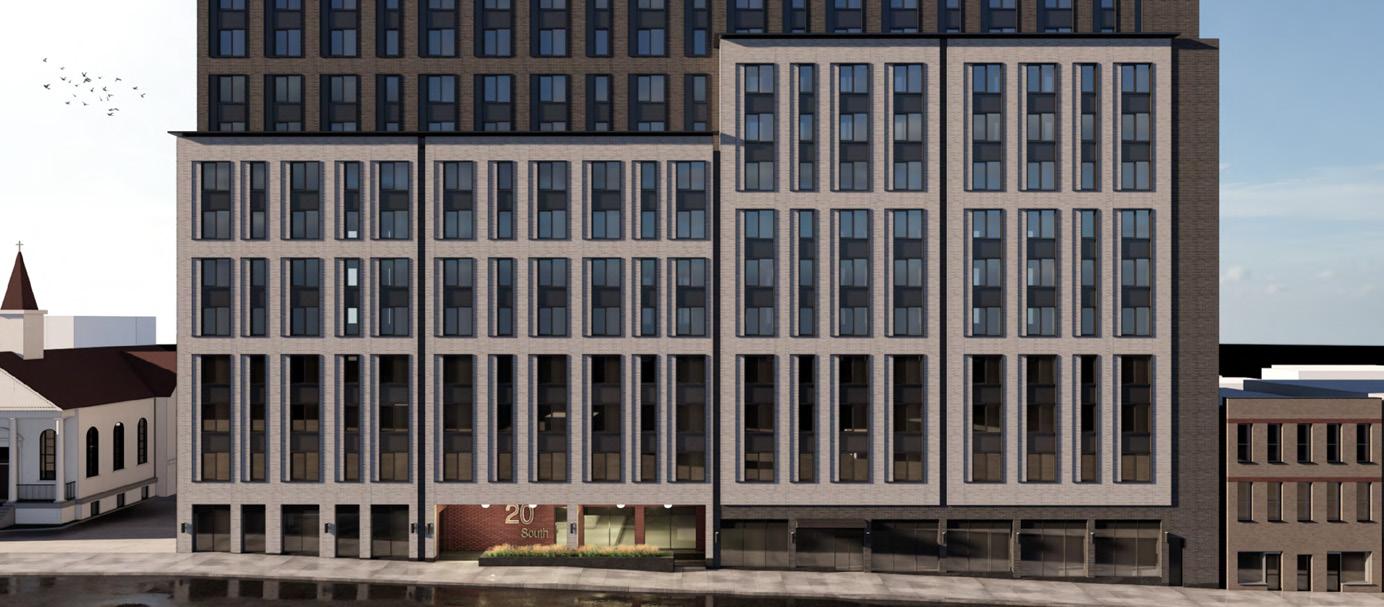


To address our role in climate change as an industry and as a firm, we strive to be carbon neutral, carefully focusing on improving the energy efficiency of our projects and reducing the carbon associated with their construction and operation.
Achieving carbon neutrality in our operations is just one part of our bigger goal; we know that as a design firm, our biggest carbon footprint lies in the work that we design every day and in the resulting buildings and places that will stand for decades to come. Achieving carbon neutrality in our design work is a major challenge; carbon is, quite literally, everywhere. The many different factors that comprise a carbon-neutral future require a multidisciplinary response. As a firm, we must focus on both embodied and operational carbon, but we must also be advocates for the development of cleaner power grids, environmentally healthier materials, and smarter technology for carbon sequestration and capture.
The AIA 2030 Commitment is both a pledge and a journey. Since 2014, we have faced the complex task of gathering and analyzing data from our vast portfolio, comprising 23 studios and 18 practice areas. It’s a challenging process, but it’s one that we have embraced. We believe in being open about our progress and in sharing what we learn, so we can contribute to the broader conversation about sustainable design in our industry.
This past year, we reported on 97% of our projects, a testament to our commitment to comprehensive evaluation. Of these, nearly half used energy-modeling, helping inform smarter, more efficient designs. Our efforts have culminated in an average predicted energy use intensity (pEUI) reduction of 48.9% against the Commercial Buildings Energy Consumption Survey (CBECS) 2003 baselines, alongside a substantial leap in projects achieving net-zero energy (NZE) from five last year to 12 this year.
Disclaimer: Only our corporate operational carbon data is third-party verified. The operational and embodied carbon analyses of our work are for demonstration purposes only and they include significant assumptions. We used data from our AIA 2030 projects, incorporating their projected energy reduction values, grid-specific energy utilization and carbon emission assumptions, and the Carbon Leadership Forum’s (CLF) embodied carbon assumptions per building use category. Please consider these factors when interpreting the results.
Although we are proud of the progress we have made toward the 2030 Commitment, our reduction average and the industry average are both significantly behind the current target of an 80% reduction from the CBECS baselines. If we are to meet this goal, we must increase energy-modeling, especially in jurisdictions where energy codes are lagging. While we have seen a small increase in modeled projects this year, there’s an undeniable urgency to accelerate our efforts. In addition, as showcased in the “Our Culture” section of this report, our commitment to educating our design teams is critical to these endeavors.
Our dedication to the 2030 Commitment is important, but it is not the only work that needs to be done to reach our carbon neutrality goal. We must explore methods for holistic decarbonization in the built environment that consider embodied carbon, existing building stock, and how the design of the built environment impacts carbon associated with transportation, manufacturing, waste management, and water use.
We are beginning to track strategies to reduce embodied carbon across our portfolio such as reuse, mass timber, lower Global Warming Potential (GWP) insulation specifications, and Alternative Cementitious Materials (ACMs) in concrete, among others. If these strategies could be implemented in all projects across our firm, the carbon savings would be over 600,000 metric tons of CO2e per year, a total equivalent to turning off 1.6 gas-fired power plants each year.
The new Computer Science Laboratory at the University of Massachusetts Amherst (UMA) utilizes a mass-timber structure, which saves carbon and provides a warm, natural aesthetic for students and faculty. The building aligns with UMA’s ambitious carbon reduction plan,”UMass Carbon Zero,” which sets the goal of 100% renewable energy use on campus by 2032.
UMA is setting the standard for colleges and universities to pursue a low-carbon future; as part of this initiative, the university has committed to reducing both the carbon emissions associated with their operations and carbon emissions associated with the extraction, manufacturing, and transportation of materials for major renovations and new construction—known as embodied carbon.
The design team recommended mass timber early in the process as a strategy to minimize embodied carbon. The team engaged a mass-timber fabricator to provide timely feedback on engineering and connection details, minimize the cost premium, and streamline the design and construction process.
Perkins Eastman performed an in-depth review of the building’s embodied carbon footprint and found that the mass timber structure reduced the carbon footprint by 60% compared to a conventional steel-framed building. The analysis follows the methodology of the LEED Building Life-Cycle Impact Reduction credit, which includes all structural elements and the building enclosure and excludes interiors and systems.




Bard High School Early College DC is a great example of how net zero energy can be achieved with existing facilities. It is the story of how, through rigorous analysis and energy-modeling, the “bones” of the school’s existing building revealed new possibilities, and resulted in small, impactful strategies for creating a high-performing learning environment—a far better outcome than demolishing and building anew.
By reusing the structure of the existing Malcolm X Community Center and designing a new thermal envelope, the Bard project saved a significant amount of resources while enhancing the thermal performance of the building. The building’s uninsulated masonry walls were replaced with a new envelope featuring continuous insulation, more energy efficient windows, and a continuous air and weather barrier. The addition of more windows and skylights allows daylight to illuminate core learning rooms while creating higher quality spaces for students and teachers. Anecdotal feedback indicates that occupant satisfaction has been extremely high. A post occupancy survey will be completed in the coming year.
Fully operational since February 2023, Bard High School
Early College DC is one of the highest performing schools in the country. In its first year of operation, the building met an EUI of 21.3 kbtu/sf/yr, without renewables.
In addition to its very efficient design and quality construction, the building has been operating at a high level, thanks, in part, to educational efforts. The design team, in conjunction with the owner and leadership of the school, developed educational programs to help teachers, students, administrative staff, and facilities staff operate the building as intended. These programs encourage occupants of the building to save energy—by pulling up the window blinds to access daylight and reduce the need for electric lighting, for example—they also serve as a teaching tool to encourage more sustainable lifestyles.


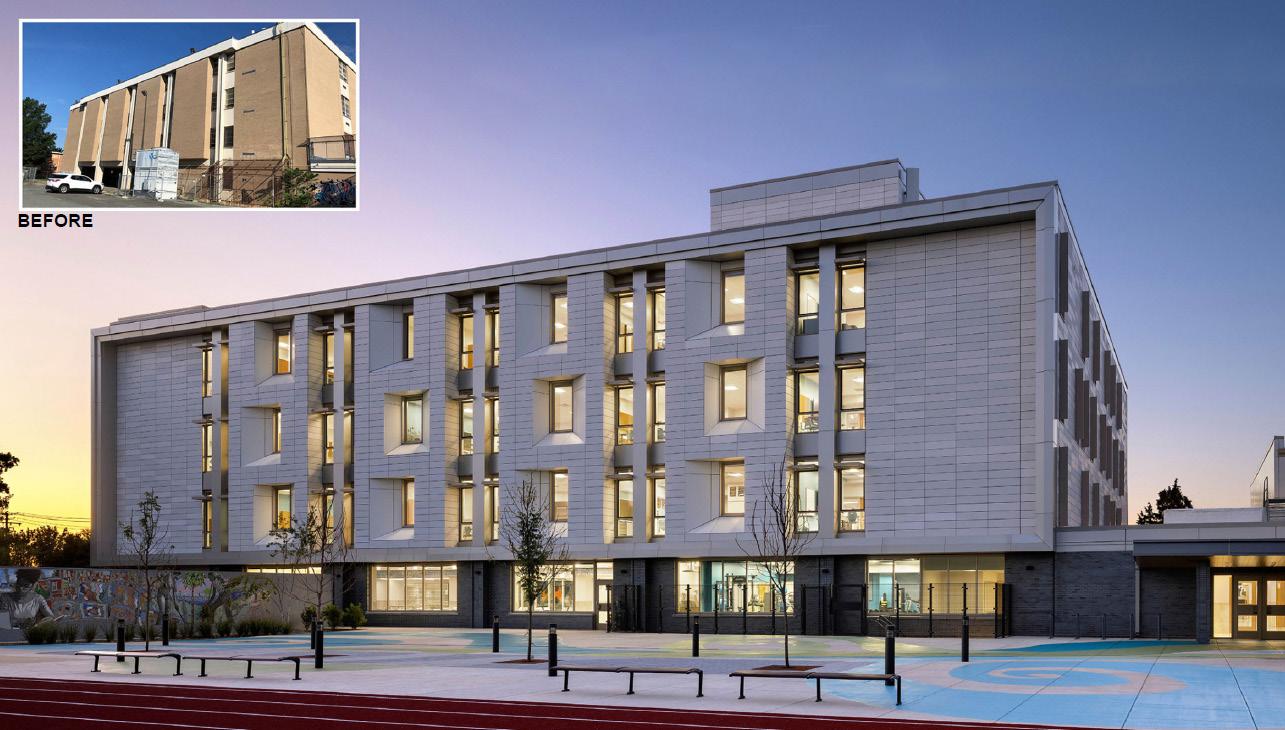
All aspects of the creation, use, and specification of materials has a major impact on the wellness of people and the planet. When selecting our materials, we must comprehensively consider human health, climate health, ecosystem health, social health and equity, and a circular economy.
In 2023, we focused on furthering our commitment to the AIA Materials Pledge through employee engagement and integrating the pledge principles within our project work.
Central to this effort, our Material Library Working Group began implementing its new library criteria for products entering the firm’s libraries; they must either be connected to the mindful Materials Portal or meet our Perkins Eastman minimum sustainability criteria. Our Boston and New York studios made significant progress this year, as highlighted in the case study on page 56.
To boost engagement and project effectiveness, we initiated collaborative visioning and action planning. This process aids in clarifying our material goals and customizing them for project teams across our diverse offices and practice areas. We began with workshops in Boston and plan to expand firmwide. These activities shape our Materials Action Plan and future visioning sessions with all studios and practice areas.
Industry leadership and advocacy were priorities in 2023. We were inaugural members of the mindful Materials AEC Forum, which was created alongside forums for owners and manufacturers to align momentum and knowledge, create common resources, and send a unified signal to the industry. Perkins Eastman staff continues to serve on industry working groups, and Tanya Eagle, our leader of sustainability standards, serves as co-chair of the AIA Materials Pledge Working Group, which released new reporting requirements in 2024.
In response to the recently released AIA Materials Pledge reporting framework, we are working to facilitate goal setting and tracking during the project process. We will continue to collaborate with our practice areas to establish priority product categories, as we aim to make material vetting and tracking accessible and relevant to all our designers.

This year, our Boston studio held a series of visioning sessions to identify the goals, actions, and metrics that are important to target when selecting materials for its library. These activities coincided with the studio’s renovation, providing an excellent opportunity to relocate the library to streamline all materials, eliminate vinyl products, and apply the adopted vetting criteria.
Similarly, our New York studio, home to Perkins Eastman’s largest materials library, has been exploring ways that it can better align with our AIA Materials Pledge commitments while creating an engaging space for better material selection. The first phase of New York studio updates included:
• Dedicating a space to call out local products and manufacturers and spotlight innovative manufacturers who are committed to producing better products for people and the planet.
• Posting informative signage throughout the library to help our staff navigate the many material health certifications and labels, and a TV monitor to highlight featured content.
• Offering handouts and information guides describing the firm’s library criteria for vendors and employees.
As a result of these efforts, all new products entering our New York materials library are vetted through our criteria. We are contacting vendors to ensure their products meet our requirements; if they don’t, we’ll remove them from our shelves.
The New York library is also identifying enhanced vetting criteria, in addition to our firmwide criteria, for vinyl products, advising that they be CDPH v1.2-2017 emissions compliant, phthalate-free, free of hazardous recycled content, and have HPD (minimum 1,000 ppm disclosure), Declare, or Cradle to Cradle certification. While we cannot eliminate all vinyl from all projects, at this time, we can apply enhanced criteria and work toward elimination of known hazards.
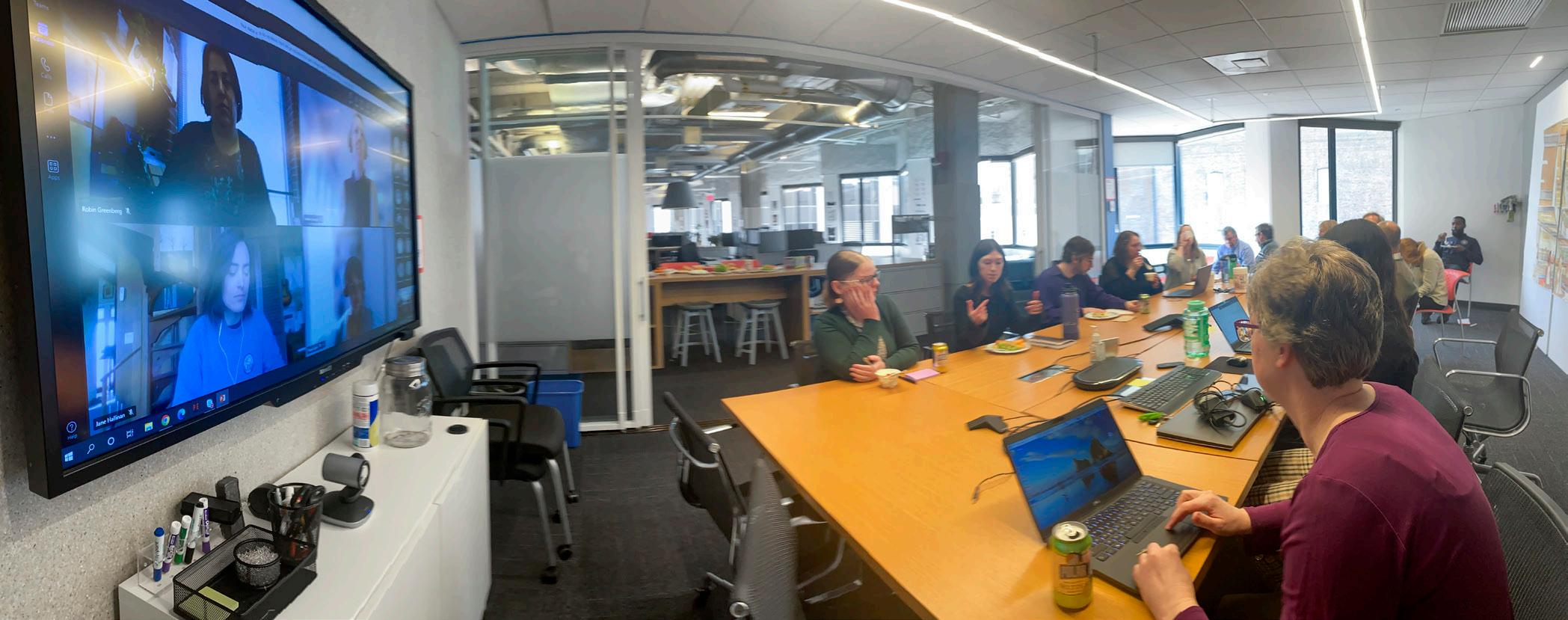
BOSTON STUDIO MATERIALS VISIONING SESSION

Our work must have a lasting and positive effect on the health and wellness of people and communities; to achieve this, we consider wellness at all scales.
Our research-driven approach to holistic wellness influences our design approach and processes. From the outset of a project, our holistic wellness framework informs goal-setting conversations that help broaden our thinking around what it means for a project to contribute to the health and wellness of people and planet. As projects progress, we implement design strategies with researched-backed impact—such as daylight and air quality. After these projects are completed, we return to measure their
impact through post-occupancy evaluations, developing benchmarks to continue improving our design process.
Though each project has different parameters, using this framework has allowed us to simultaneously maximize social and environmental impact. The case studies on the following pages are emblematic of how this broader thinking brings more value to our work.
People/Built Environment
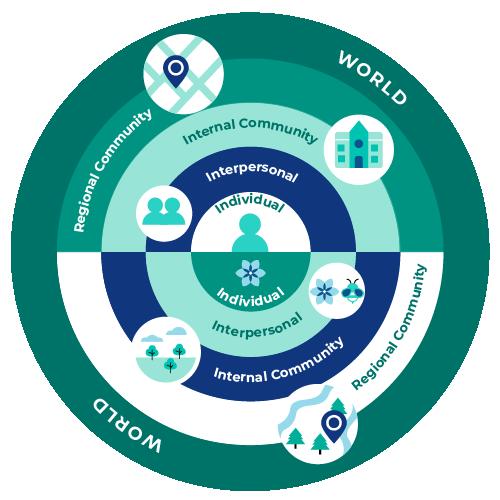

Upon completion of a new independent living building on its evolving campus, the Heritage Community of Kalamazoo (HCK) decided to develop a wellness master plan, one that would guide the wellness of residents at all stages of life and the well-being of staff and neighborhood residents.
We facilitated discussions and exercises to assess campus wellness and clarify goals, ensuring all voices were heard. Despite overlap in desired outcomes, exercises also revealed strong differences between residents and the steering committee, sparking a meaningful discussion to set core values for all stakeholders.
Developed through a consensus-driven process, the result of this engagement is a wellness master plan that provides phased recommendations to help HCK move forward thoughtfully and deliberately. The three-phase, 10-year plan involves both physical solutions to identified challenges as well as educational opportunities to help shift campus culture.
1. Curate a series of spaces that support a variety of social interactions
2. Cultivate intergenerational connections that are spontaneous and organic
3. Address wellness at all stages of life and all abilities
4. Create opportunities to eliminate silos and limit clique-like behaviors
5. Intentionally invite the outside community onto the campus
ACTIONS
A. Develop a branded, robust wellness program
B. Energize residents and utilize their experience
C. Redesign internal walking loop
C. and D. Walking loop and communicating available spaces on campus
C. and D. Walking loop and Wellness Map
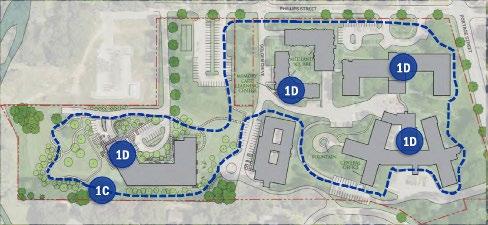
PHASE 1 | KEY LOCATIONS

PHASE 2 | KEY LOCATIONS
PHASE 3 | KEY LOCATIONS locations for recommendation interventions identified build over three phases.

PHASE 1 | KEY LOCATIONS LOCATIONS LOCATIONS
Locations identified on these phased master plan diagrams correlate with recommended interventions to help the Heritage Community of Kalamazoo achieve the goals and actions identified to the left.
Evidence from Benjamin Banneker Academic High School and John Lewis Elementary School in Washington, DC
We implemented our Net Positive Education™ (NPE) design strategies to modernize Benjamin Banneker Academic High School and John Lewis Elementary School in Washington, DC. NPE design employs evidence-based research to push the boundaries of net zero energy, helping to create a high-performing school in terms of building, human, and educational performance. To understand the impact of NPE design strategies on these schools and their occupants, our design research team conducted pre- and post-occupancy evaluations using quantitative and qualitative assessments exploring Indoor Environmental Air Quality (IEQ). Through these analyses, they addressed the following question: How successful were the modernizations of Benjamin Banneker Academic High School and John Lewis Elementary School in meeting performance-based goals?
Benjamin Banneker Academic High School:
• More comfortable thermal conditions (27% more time spent in the comfort zone)
• Enhanced air quality (34% lower average CO2 levels)
• Comfortable acoustics (95% of teachers and 89% of students are satisfied with the noise levels in classrooms)
• Better daylighting (12% increase in well-lit areas)
John Lewis Elementary School:
• More comfortable thermal conditions (70% more time spent in the comfort zone)
• Enhanced air quality (30% reduction in average CO2 level)
• Quieter classrooms (5.7 dBA lower average background noise level)
• Improved satisfaction with classroom brightness and visual comfort (90% teacher satisfaction)
Through our implementation of NPE design strategies, we have revolutionized the IEQ of these schools and positively impacted human health and well-being, which are catalysts for enhancing positive educational experiences.
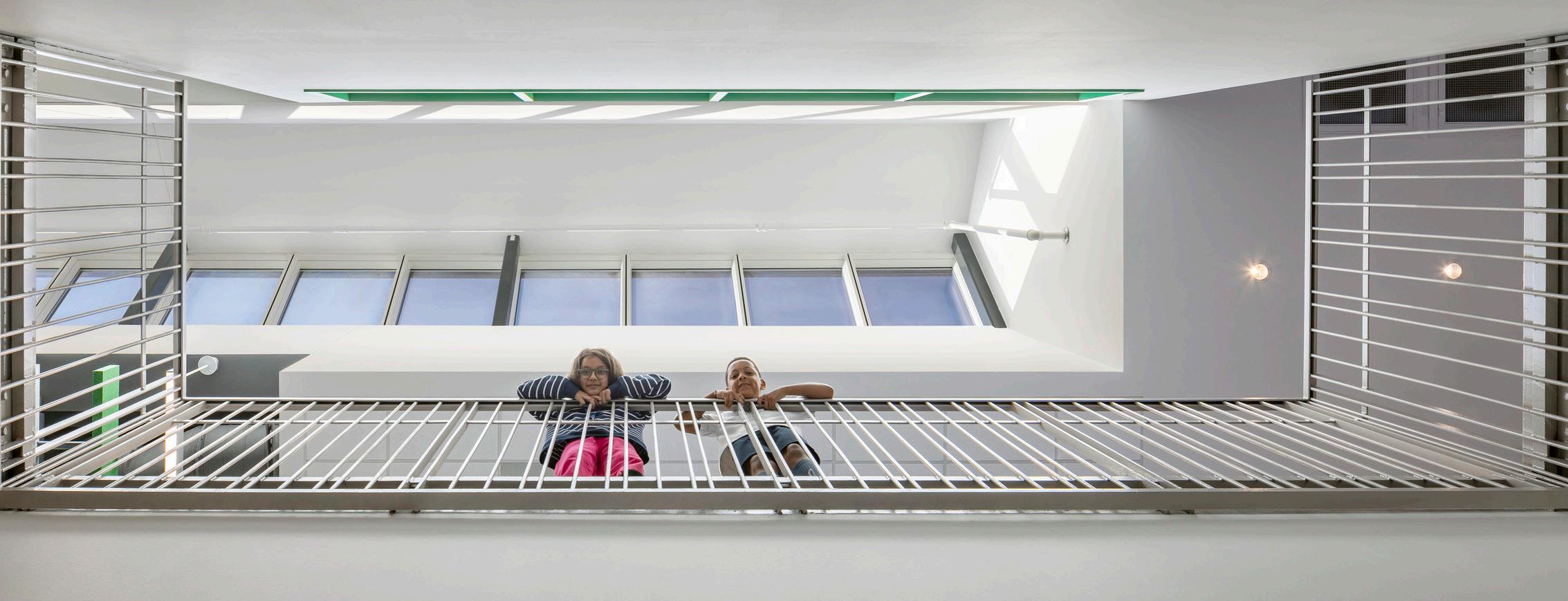
JOHN

Curiosity drives our creativity—it fuels our applied research and inquiry and advances our work.
To deliver on our Human by Design ethos, we must measure the impact of our designs. Our Design Research, Design Strategy, and Sustainability teams support our firm’s culture of inquiry. These trained researchers help our design teams answer questions that center around how our work can impact the human experience.
In addition to our internal research team, our external collaborations have been critical in expanding the scope and impact of our research. The founding of the Consortium for Design and Education Outcomes (CDEO), a partnership with Drexel University, resulted in the recent publication of one of the most comprehensive reports on how school design impacts occupant’s educational outcomes—highlighted in the case study on the following pages.
The deeper we go, the more curious we become. While there is a growing body of research highlighting the value of good design, significant gaps in the literature need to be filled. For example, the more we understand the role acoustics play in school environments, the more we realize that further research is necessary to inform occupied noise levels in classroom environments. Similarly, the further we delve into targeting deep reductions in embodied carbon across our portfolio, the more we realize that we need to expand our life-cycle assessments to include factors like the impact of mechanical systems on the life cycle of a building. With the support of our research groups and external partnerships, we continue to question, research, publish, and share our knowledge with the industry.


Free Address, Work from Anywhere, and Everything in Between: Lessons learned from the flexible new workplace design and policies of Perkins Eastman’s Pittsburgh Office
Addressing a Multi-Billion Dollar Challenge: Advancing Knowledge of How High-Quality School Environments Can Positively Affect Educational Outcomes

In 2019, The CDEO, a partnership between Perkins Eastman and Drexel University, received the Latrobe Prize from the AIA College of Fellows, with additional support from J+J Flooring to produce a study on educational environments. Confronting the nation’s inadequate school facilities is essential for equitable educational and community improvement. More than half of US public schools need renovations; the total cost is nearly $200 billion. The study, “Addressing a Multi-Billion Dollar Challenge,” aimed to highlight the benefits of school modernization, aiding municipalities in securing funding and guiding designers and school districts on effective spending. Researchers from Perkins Eastman and Drexel University examined differences between 28 modernized and non-modernized schools in two urban districts, focusing on IEQ, educational adequacy, and community connectivity. Findings showed that modernized schools significantly outperformed non-modernized ones in IEQ and educational adequacy, with community connectivity results being mixed but generally positive.
Modernized schools have:
• approximately 24% more time spent in the thermal comfort zone as compared to non-modernized schools;
• lower temperature swings, of 4° Fahrenheit on average;
• significantly lower average particulate matter in the air, compared to non-modernized schools: 11.7 μg/m3 versus 21.4 μg/m3;
• significantly lower average background noise levels, by 2.4 dBA, bringing them into compliance with the LEED for Schools prerequisite for acoustics.
Modernized schools are:
• on average, 18% less underlit and therefore, less reliant on electric lighting than non-modernized schools.
Of 28 schools in the sample, 14 modernized scored over 70% on the visual assessment tool used to help evaluate educational adequacy, compared to only two non-modernized schools.
Of the 28 schools, 11 modernized schools scored higher on the visual assessment tool used to help evaluate Educational Adequacy than any of the (11 total) non-modernized schools.
The study revealed that school modernization made a significant impact across multiple Indoor Environmental Quality and educational adequacy factors.
The greatest differences between modernized and non-modernized schools occurred within the following areas:
• instructional space ambiance in terms of infrastructure, color, and finishes;
• exterior presence in terms of the building’s architecture, entry, and community access;
• safety and security in terms of the building’s entry and overall design;
• community assembly space(s);
• location of main office;
• IEQ air quality, in terms of particulate matter and thermal comfort, and acoustics, in terms of background noise and daylight.

Resiliency, like sustainability, is often used as a buzz word with its definition and scope limited to climate change and natural disasters. The broader definition of resiliency must incorporate social, economic, and environmental factors across a variety of scales. True resiliency allows us to prepare for an uncertain future that includes both immediate shocks and long-term stressors.
Our Planning + Urban Design and Large Scale Mixed-Use practice areas are working to integrate this broader definition of resiliency and sustainability into their processes. These groups have been working with our Practice Area Metrics subcommittee to develop what we call Metrics of Success, which can be used as guidelines for new and existing projects. These metrics allow our teams to implement performance targets during the early stages of design and serve as a resource for us to identify the highest and lowest performing projects in our portfolio.
Our Planning + Urban Design and Large Scale Mixed-Use practices have been particularly invested in this effort, as their complex and far-reaching work can be the most challenging to measure in terms of sustainability (specifically, by traditional metrics such as energy). Our success metrics prompt teams to broaden their thinking, help set clear targets at early stages, and enable us to evaluate a project’s performance through its entire life. One of the most notable projects that completed the metrics exercise is Southeast False Creek, a neighborhood in Vancouver, Canada, which is highlighted in the case study that follows.
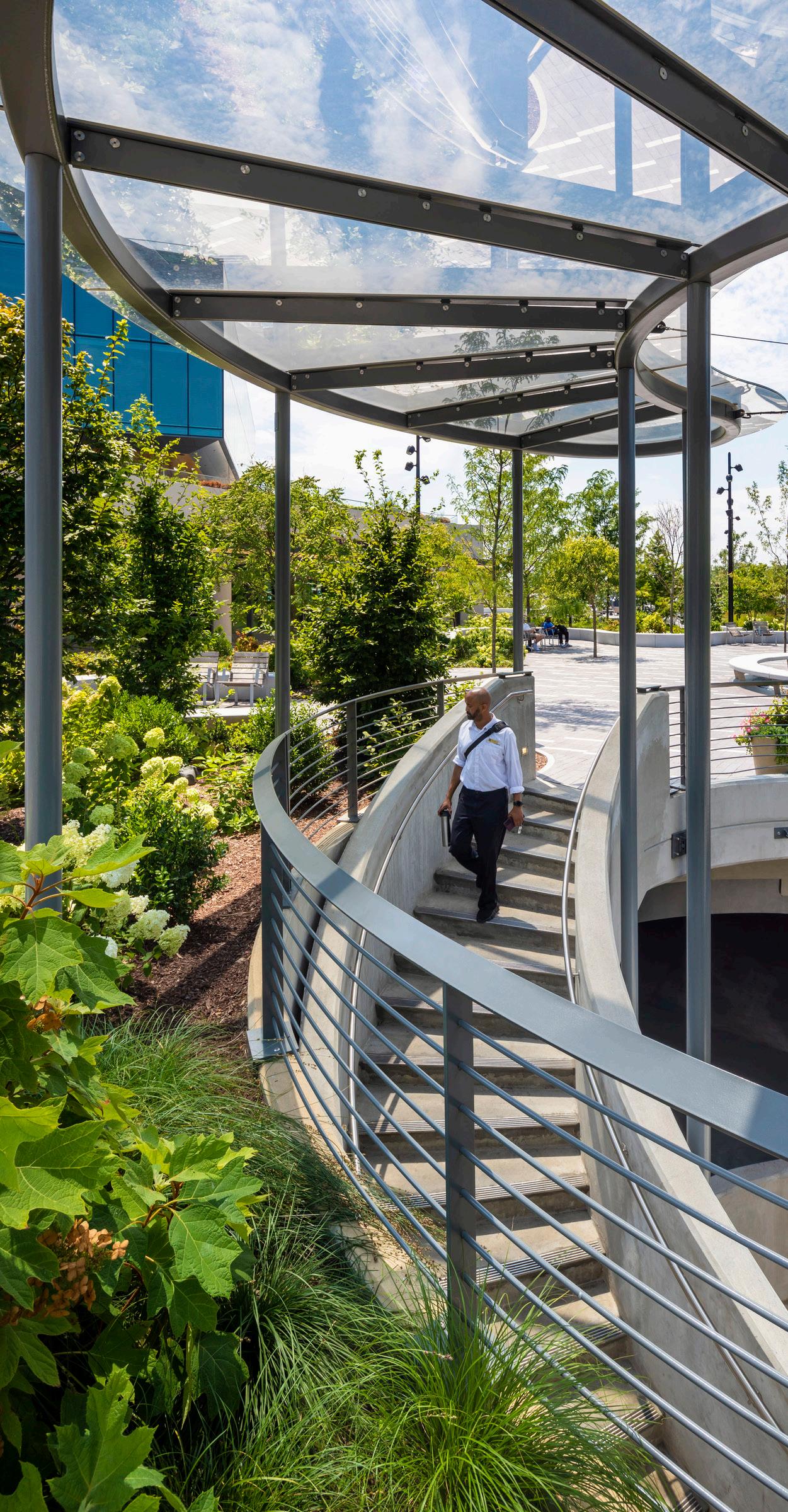
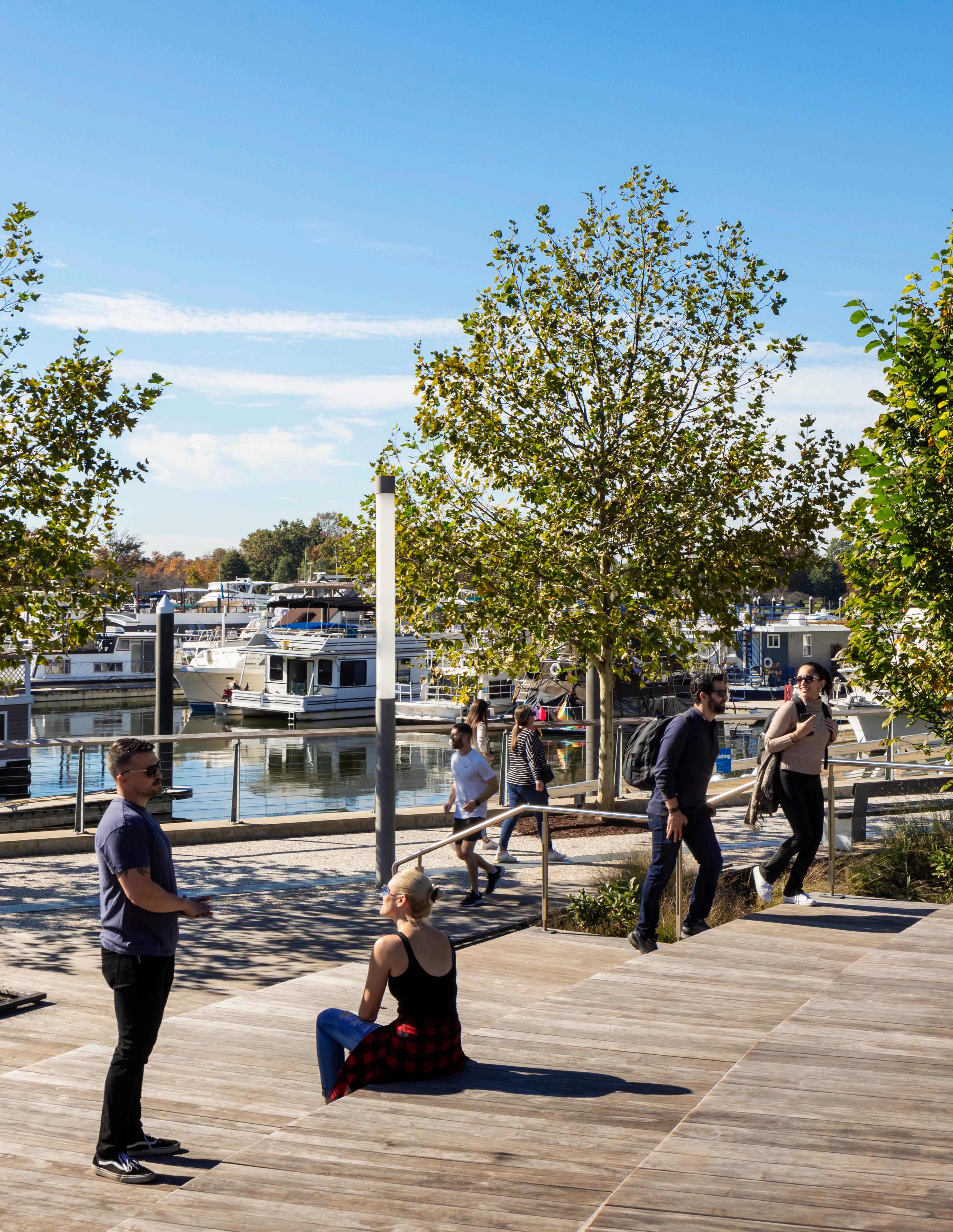
Our development plan for Southeast False Creek focuses on conservation and restoration, emphasizing sustainable management of transportation, energy, waste, water, and food. Designed as a mixed-use community for 11,000 to 13,000 people, it transforms an industrialized area in Vancouver into a sustainable, resilient neighborhood.
To address the risk of flooding from the nearby False Creek ocean inlet, the plan includes seawalls and stormwater management strategies. No permanent structures are allowed within 98.4 feet of the waterfront, creating green buffer zones for flood protection. Renewable energy is provided by a central utility plant that captures thermal energy from sewage, which, ideally will neutralize greenhouse gases in the neighborhood.
The mixed-use development offers diverse housing options for all income levels, with an emphasis on family housing, promoting vitality, diversity, and cultural richness. The area’s history spans more than 10,000 years, from early Northwest Coast settlements to significant industrial development. Recent efforts focus on redevelopment, remediation, and densification, reconnecting the city with the waterfront while safeguarding it through shoreline reconfiguration.
Government and local resident involvement in decision-making was prioritized throughout the development process. The plan also promotes a variety of transportation modes to reduce car dependency and greenhouse gas emissions. This includes pedestrian, cycling, and transit facilities, supported by ongoing monitoring and programs encouraging walking, biking, and transit use. Community transit passes and new local transit services will be reported to the city council as part of this coordinated approach.

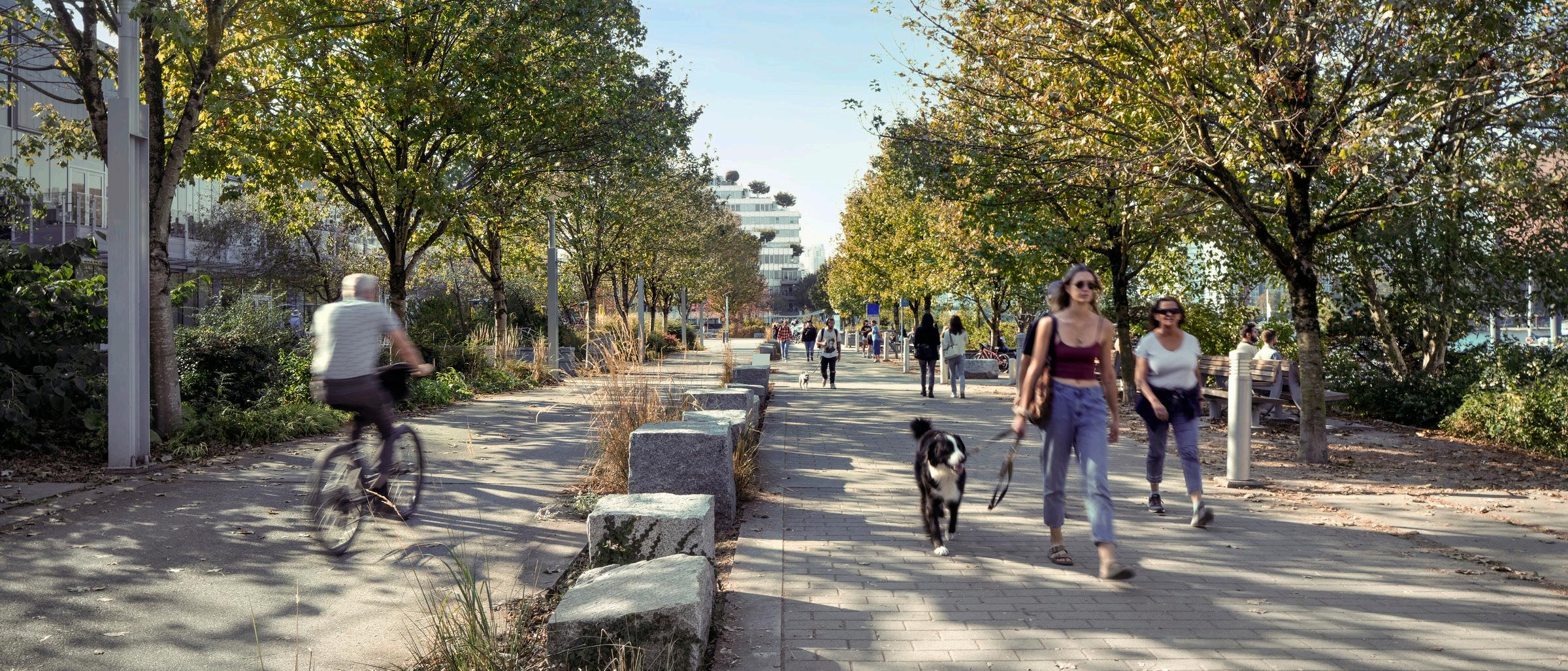

Photography
Photograph Andrew Rugge/Copyright Perkins Eastman, Pages: Cover [District Wharf], Inside Front Cover, 2-3 [Table of Contents], 5, 11, 29, 43 [Brooklyn Crossing and New York Methodist Hospital], 55, 68, 69
Copyright Tom Bonner/Courtesy Perkins Eastman, Pages: 8-9 [Our Culture]
Photograph Perkins Eastman Staff/Courtesy Perkins Eastman, Pages: 19, 21, 23, 24, 25, 37, 57 [Boston Studio Materials Visioning Session]
Copyright JAG Studio/Courtesy Perkins Eastman, Pages: 26–27 [Our Operations], 43 [Perkins Eastman Guayaquil Studio]
Copyright CarbonCure Technologies/Courtesy Perkins Eastman, Page: 35 [CarbonCure]
Copyright Cloverly/Courtesy Perkins Eastman, Page: 35 [Bukaleba Forest, Skylands Region Grocer, Indian Carboneers, and Buena Vista Heights]
Copyright Tian Fangfang/Courtesy Perkins Eastman, Pages: 38–39 [Our Work]
Copyright Joseph Romeo/Courtesy Perkins Eastman, Pages: 41, 43 [Benjamin Banneker Academic High School], 53 [Bard High School Early College DC], 59, 63 [John Lewis Elementary School and Benjamin Banneker Academic High School]
Copyright Ray Cavicchio/Courtesy Perkins Eastman, Page: 43 [1100 Ludlow]
Copyright CreatAR/Courtesy Perkins Eastman, Page: 43 [Tianquan Lake Wellness Senior Living Community]
Copyright Michael Elkan/Courtesy Perkins Eastman, Pages: 43 [Centerm Port Expansion], 70–71
Copyright Jeffrey Totaro/Courtesy Perkins Eastman, Pages: 43 [Canopy by Hilton], 73 [Inside Back Cover]
Sketch Omar Calderón Santiago/Copyright Perkins Eastman, Page: 53
Photograph Sean Gold/Copyright Perkins Eastman, Page: 57 [New York Studio Materials Library]
Copyright Robert Benson/Courtesy Perkins Eastman, Page: 67
Document Prepared By
Sustainability Team (Koray Aysin, Ryan Dirks, Tanya Eagle, Juan Guarin, Heather Jauregui, Ana Cristina Muñoz, Widya Ramadhani, Claire Turvill, Christine Vöhringer)
Jennica Deely
Emily Pierson-Brown
Laura Schmaeler
With special assistance from:
Communications Team (Emily Bamford, Abby Bussel, Trish Donnally, Jennifer Sergent, Brooke Sullivan)
Sustainability Advisory Committee (Dan Arons, Eric Fang, Scott Fitzgerald, Jason Harper, Stephanie Kingsnorth, Nick Leahy, Jesse Mallen, Mary Rankin, Wolf Saar, Jerry Walleck)
Visual Assets Team (Caroline Donadio, Sean Gold, Sarah Mechling, Andrew Rugge)
Kim Rader
Green Coordinator Network
Sustainability Leads
Contact us to learn more sustainabilityteam@perkinseastman.com
© 2024 Perkins Eastman. All Rights Reserved.
